Darwin She Didnt Realize She Shouldnt Hand Feed a Shark
There are no tourists, the land is barren and volcanic, it's almost impossible to reach, and it's waters are filled with sharks. This is Ascension Island.
It has been the question mark of our Atlantic Ocean Crossing since I was first invited to join SV Delos over ?ve months ago. Ascension Island is incredibly remote, and known as a world class destination for spear and sport fishing. Up until recently, I had never even heard of it.
Sitting almost smack dab in the middle of the South Atlantic, somewhere between South America & Africa with at least 1,000 miles of deep blue in all directions, the aquatic life here has flourished since this ancient volcano rose out of the sea one million years ago. The island is teeming with Tuna, Wahoo, Mahi, Turtles and as of late- an exceedingly high population of Galapagos Sharks that are rumored to be getting a bit aggressive. After setting sail from Walvis Bay, Namibia and spending two weeks on it's big sister island of Saint Helena, our curiosity to explore Ascension was peaked. We unanimously agreed that the 730 nautical mile sail North to explore this mysterious island was well worth it before we turned Delos South to complete our ocean crossing to Brazil. In true Delos style we unknowingly arrived at a very interesting time in Ascension's history, met some incredible locals, and in just 3 weeks fell in love with this rugged and raw underwater paradise.
 Sailing towards the Southern tip of Ascension Island at sunset after 5 days at sea.
Sailing towards the Southern tip of Ascension Island at sunset after 5 days at sea.
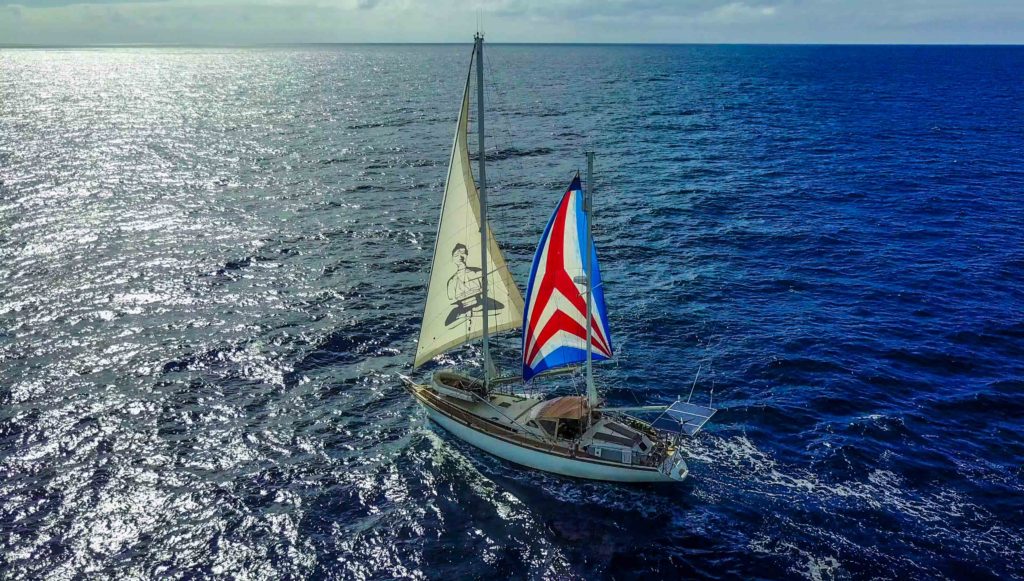 SV Delos cruising along with full sails for an average speed of 7 knots from Saint Helena.
SV Delos cruising along with full sails for an average speed of 7 knots from Saint Helena.
Ascension's first recorded discovery was in 1501 by a Portuguese navigator, but was not settled until 1815 by the British as a strategic military base. Nineteen years later Charles Darwin visited the island and after noticing its lack of natural vegetation, encouraged his botanist friend, Joseph Hooker, to plant a man-made tropical forest on the highest mountain. Besides what became affectionately known as "Green Mountain", the entirety of the island is characterized by jagged black lava flows that act as constant reminder to how juvenile and undeveloped this land mass actually is. American presence rose and declined over the years in relation to World War II & the Space Race, but it was the US Air Force that extended Ascension's only runway in the 1960's. Their goal was to build a safe landing strip for the Space Shuttle if something went wrong after a launch from Cape Canaveral, Florida.
There are some interesting structures on the island which no one seems to have access to, but the locals explained are related to relaying information for space exploration and radio transmissions Currently, this little known island hosts one of the few GPS Ground Relay stations in the world, a European Space Agency tracking station, NASA tracking station, BBC Relay station, and last but not least one of the US Air Force space radars that track space trash in orbit. All on this little speck of rock!
 Man-made Bamboo forest at the very top of Green Mountain.
Man-made Bamboo forest at the very top of Green Mountain.
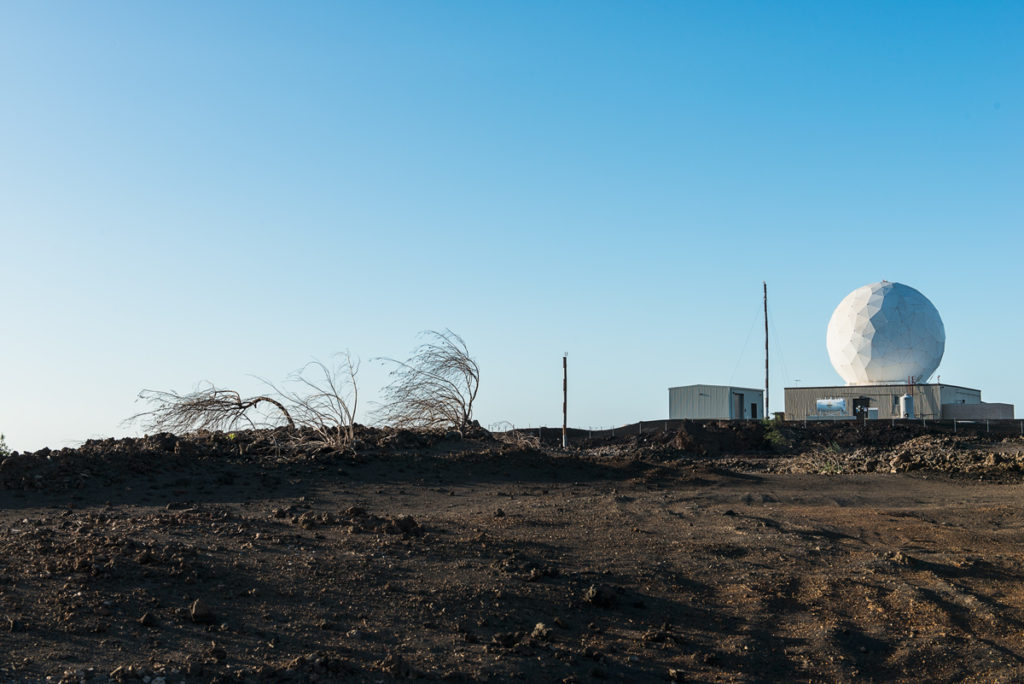 One of several curious structures on the Island.
One of several curious structures on the Island.
Today, the island is inhabited mostly by 'Saints', a nickname for locals of Saint Helena who have moved to Ascension for work opportunities. The population is interestingly mixed with members of the RAF (Royal Air Force) & US Military Base, who tend to come and go in 2-3 year contracts. Upon arrival on Ascension, it felt almost abandoned in stark contrast to St. Helena that's overflowing with unique history, lush jungle and charismatic people. On our first mission to land we walked around the oddly spread out town to find the only hotel, post office, conservation headquarters, dive shop and bar to all be closed. It didn't take us long to learn that this was due to the one runway on the island being deemed too damaged for the RAF Airbridge Voyager to land, which was the only civilian flight for tourists. It turns out that same runway from the 1960's had finally been overtaken by deep pot holes. The local government, RAF & US Base are in discussions about who should fix the airport but we got the feeling it may be at least a few years.
But Delos didn't sail to Ascension for what we had hoped to find on land. We had heard the rumors of warm clear water, huge pelagic fish, turtles, rays, and big curious sharks… So, what we were in search for was under the water.
 The crystal clear waters of Ascension island, looking down from the main pier.
The crystal clear waters of Ascension island, looking down from the main pier.
While on St. Helena, we started to hear about the Galapagos sharks in Ascension behaving aggressively. A shark attack had taken place at the popular English Bay a few months back, and on such quiet islands it definitely seemed to be the talk of the town. The first day we arrived in Ascension, the fisherman on the pier & the Harbor Master warned us not to swim off Delos, around the pier, or at any of the beaches. Even the cashier at the local grocery store was eager to tell us, once again, the story of the lady who was attacked and then saved by her hero husband. Although I heard all of these warnings, I still wondered if the people giving them had spent much time in the water. I was interested to meet some more experienced divers who knew the behavior of the sharks first hand.
 News clipping from Daily Mail. Mrs. Gonsalves has healed well from her injured Achilles Tendon.
News clipping from Daily Mail. Mrs. Gonsalves has healed well from her injured Achilles Tendon.
I asked the crew if they were still feeling as keen on diving as when we had first arrived. Brady broke it down, "Sharks are indeed dangerous predators just like lions or tigers and will eat when given the chance. But do I think sharks are programmed to eat Humans? Of course not. Sharks are the ocean's cleaners and over millions of years, have developed by surviving while using as little energy as possible. They go for scraps, dead, injured or weak targets. If they happen to mistake a human as a natural source of food, history has shown that they usually stop and realize you're not what they thought you were."
Brian added "We've done a fair bit of diving with sharks. We've had the honor of swimming with grey sharks, white tips, black tips, hammer heads, lemon sharks, and a few others. Brady even dove with bull sharks and tiger sharks in Fiji, and all three of us did a cage dive with Great Whites in South Africa. Most of the time they are like little puppy dogs, and mostly curious keeping a respectful distance. We're no experts, but I do think we're starting to recognize different types of behavior, from "curious shark" to "hey you just speared something and I want it!" If a shark starts to arch their backs and swim aggressively with fast tail swipes instead of gliding silently past you something may be amiss. Most of the accidents I've heard about are an unfortunate case of mistaken identity, which is why I prefer to be under water with them diving rather than on the surface.
Karin chimed in after, "This isn't the first time I've heard horror stories about sharks. It's sad how scared I was of sharks from a very young age having grown up in the Northern part of Sweden so far away from them. I remember watching "Jaws" and being scared going to the toilet for weeks afterwards. But after spending some time in the water diving with sharks over the last years I definitely have big respect for these creatures but I have also realized that they are possibly one of the most misunderstood creatures on our planet… so I'm still keen to see what's down there!"
 Looking down on Clarence Bay from the Pier at Sunset.
Looking down on Clarence Bay from the Pier at Sunset.
Our first few days on this island were spent familiarizing ourselves with the small town & led us to meeting some very interesting individuals. One of the first characters was Dave, an ex-cop from the UK who had been sent to Ascension to train the Sea Rescue team made of up local fire fighters. The day we met him, he happened to have an Ascension scuba diving guide with him. It was perfect for us as we were using the expensive & slow local internet to try and research the dive sites of the area. We soon had detailed descriptions, photos, & recommended routes for 20+ dives around the Island.
Our next encounter was with a seasoned Saint, Mitchell, who had been living on Ascension for about 12 years after growing up on St. Helena. He was just returning from his day off work, which he always spent ?shing off his tiny center-console boat. We chatted with him for over an hour as he gutted the several small to medium sized grouper he had brought in. As he chucked the guts over the pier wall to the shallow water on the beach, it quickly became clear why we were warned not to swim in from the dinghy or anywhere near the pier. As we chatted about the ocean, he speculated that the sharks had become accustom to the large amounts of chum used by the spear fishing boats for the last ten years. Now with the island being close to empty, he believed the sharks were wondering where this food supply had gone and therefore coming closer to land. He also mentioned that even the oldest divers on the island, who had been diving since the 60's, had decided to no longer enter the water due to the sharks. Over the next weeks we would learn that everyone had their own personal theory and that most seemed to completely contradict one another.
Even after all the stories, warnings and late night conversations we decided we were ready to find out for ourselves what was going on in the water. After taking into account the possibilities and dangers of diving here, we decided on a simple dive a couple miles from our anchoring in Clarence Bay.
Now, I think I should mention here that Brian, Brady & Karin have been living aboard and diving off of Delos for about the last 8 years. They had swam with hundreds of sharks in multiple different countries, and their confidence and skill level in the water is high. I had been diving in Central & South America over the last few years, but had only ever encountered friendly little reef sharks in the water. However, I fully trust the crews ability to asses a diving scenario and make logical decisions based on past experiences. I knew I was a bit out of my league here, but I had been mentally preparing myself for coming face to face with these dinosaurs of the ocean, and sitting this one out just wasn't an option.
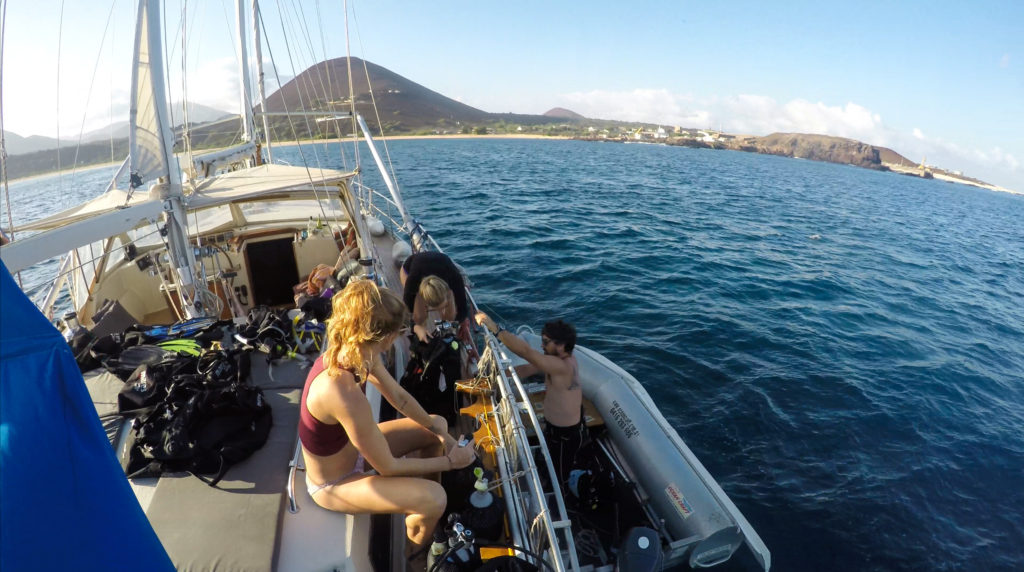 Prepping dive gear on Delos and loading it into our trusty Dinghy- Maggie.
Prepping dive gear on Delos and loading it into our trusty Dinghy- Maggie.
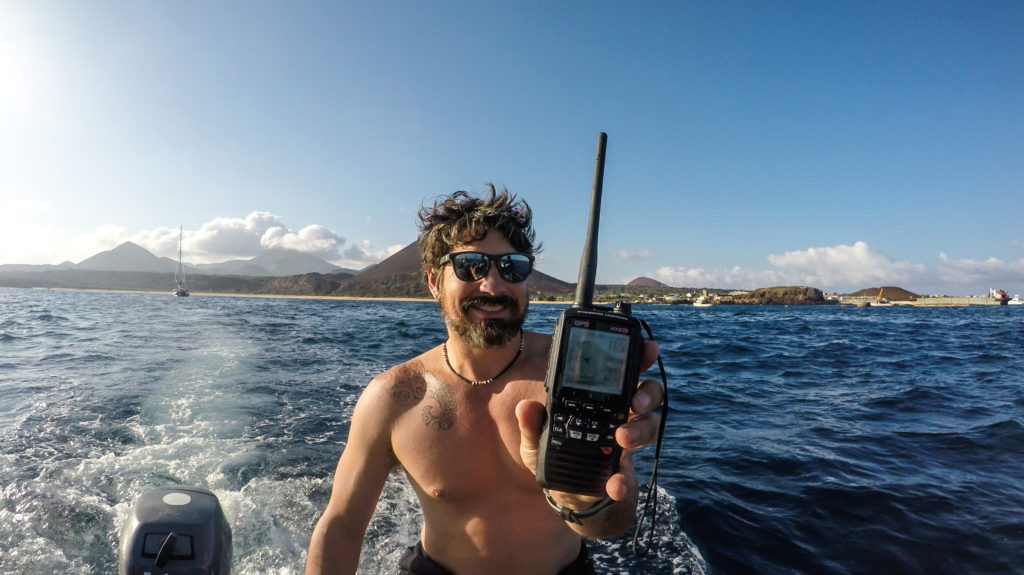 Captain Brian leading the way to the Arch.
Captain Brian leading the way to the Arch.
Anxious but curious, we decided to go on our first dive. We settled on a simple dive a couple miles out from our anchorage in Clarence Bay called "The Arch". We prepped our gear, loaded up the dinghy, punched in the GPS & made our way towards the dive site. We would be diving in two teams- The Captain of our boat, Brian, and his girlfriend, Karin, made one team. I would be diving with Brian's brother, Brady, who used to be a Scuba Instructor in the Florida Keys. We approached our coordinates, buckled into our BCD's, turned on our air, and back rolled into the beautiful clear water. As we sank down to about 15 meters, the beauty of the scene instantly washed away our anxiousness. We were surrounded by the black lava rocks & ridiculous amount of trigger fish which we would come to learn are the underwater norms of the island. As we made our way towards the arch full of big eyed Squirrel fish, we saw Grouper, Trumpet ?sh, Trevally and a lone Puffer fish. We chilled around the arch for a bit, just taking it all in and enjoying shooting with our Panasonic Lumix GH4.
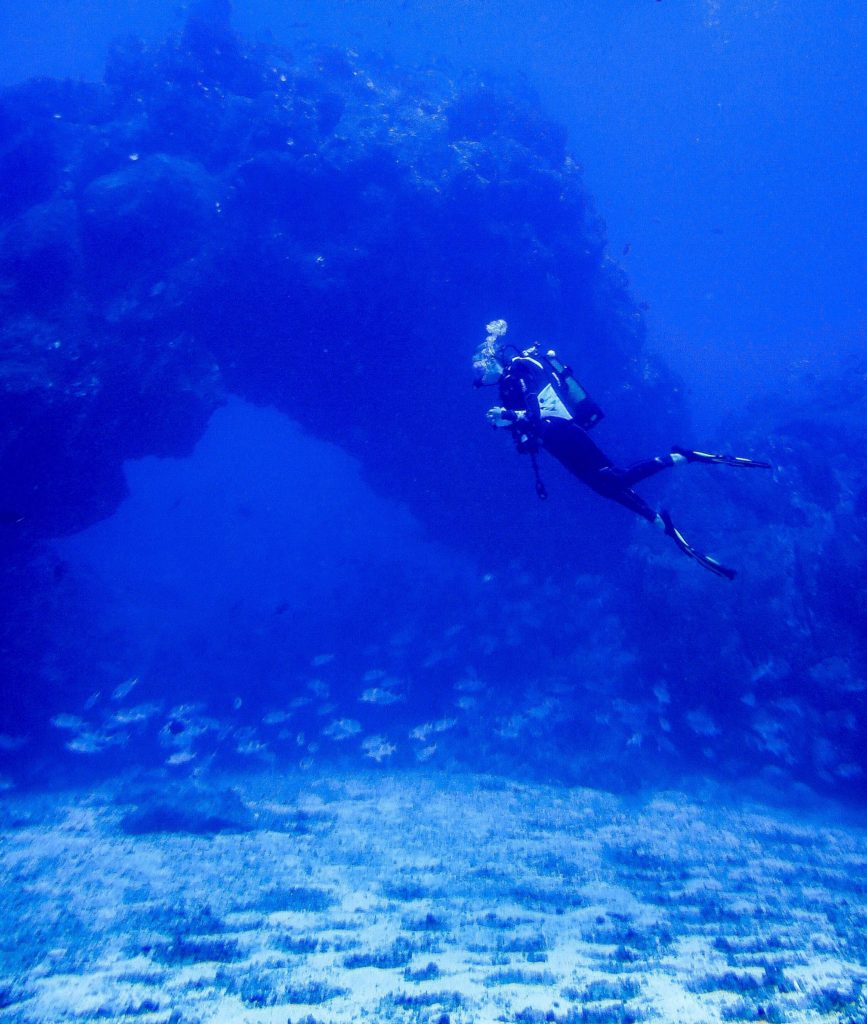 Looking through the Archway in Clarence Bay.
Looking through the Archway in Clarence Bay.
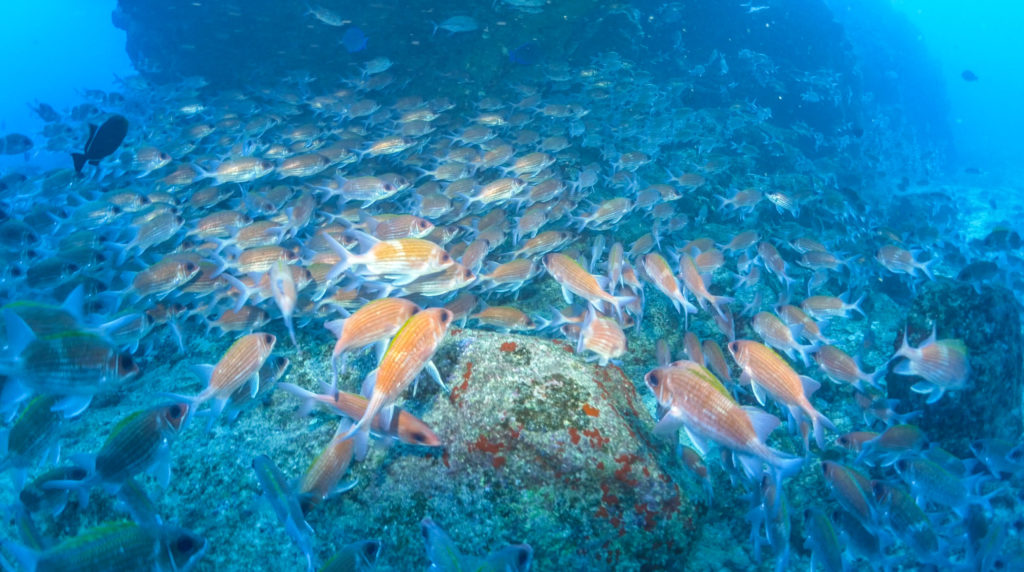 Massive school of Squirrel Fish chilling under the Arch.
Massive school of Squirrel Fish chilling under the Arch.
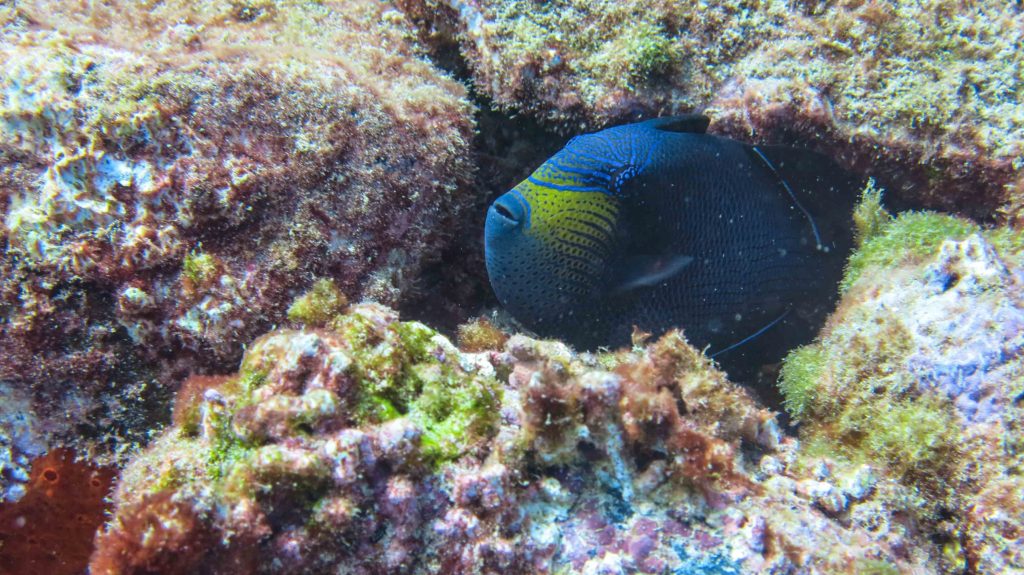 These Trigger Fish are plentiful around the island and act as a main food source for larger ?sh.
These Trigger Fish are plentiful around the island and act as a main food source for larger ?sh.
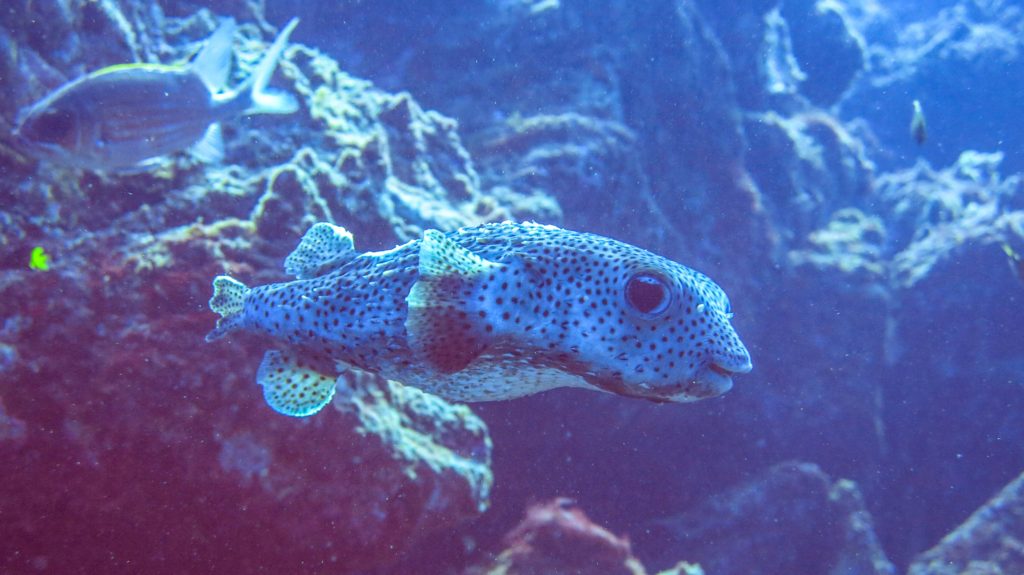 Friendly little puffer ?sh smiling for the camera.
Friendly little puffer ?sh smiling for the camera.
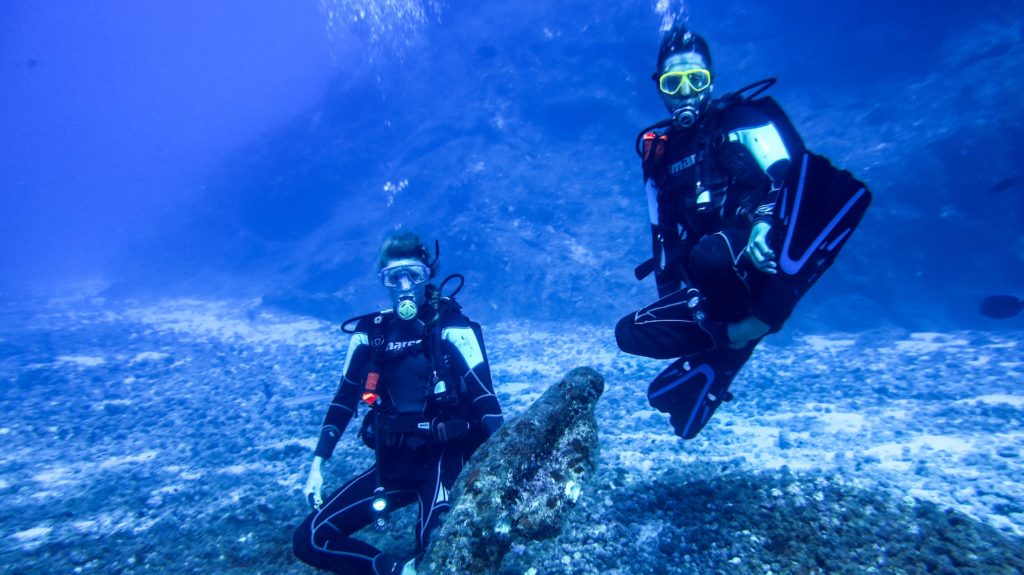 Alex & Brady checking one of the many massive anchors littered around the coast of Ascension.
Alex & Brady checking one of the many massive anchors littered around the coast of Ascension.
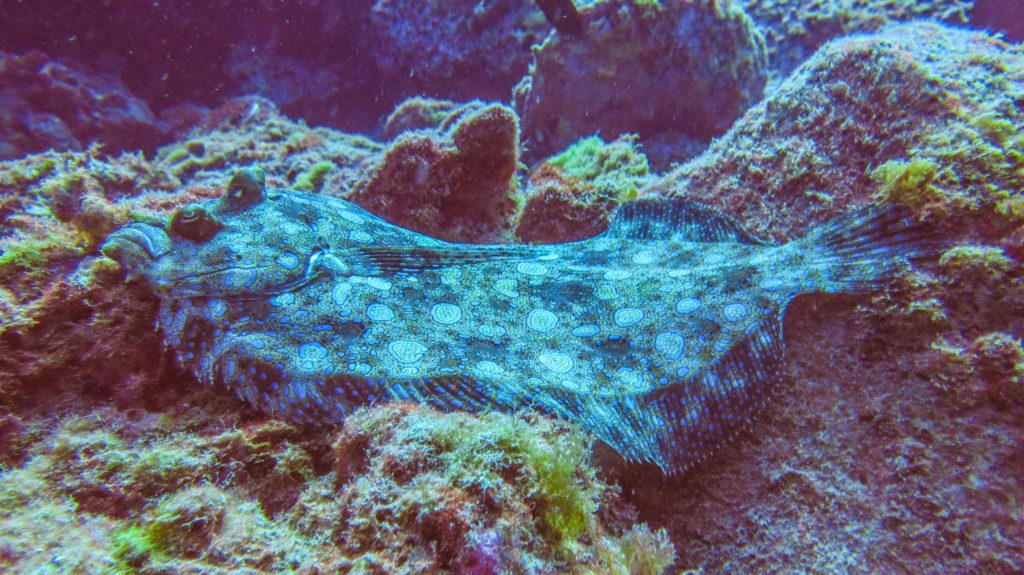 Flounder ?sh caught for once in a not so camouflaged hiding spot.
Flounder ?sh caught for once in a not so camouflaged hiding spot.
We swam through the other side of the arch and hugged the rock wall for a bit until making our way over to a massive anchor out in the open sand about 10 meters away. Just then from behind the anchor, a 10 foot Galapagos shark appeared and cruised towards us. We ?lmed and watched in awe as this beautiful creature circled around us, at ?rst staying a cautious ?ve or so meters away. I can only imagine what goes through the sharks' brain at this point. Is this thing food? Is it weak? Is it injured? Typical shark behavior entails them checking you out before realizing this big alien creature blowing bubbles and making loud noises isn't food. But this shark was actually coming closer and closer, all but rubbing up against us to feel our vibrations with his lateral line sensory receptors.
We started to swim back towards the rock wall and he was right by our side. There was a bit of a current, so our kicking led to a higher heart rate, which in turned seemed to feed the interest of this great beauty. He would swim off and disappear for a few moments, then bolt back to us with his back slightly arched and ?ns tucked in before making a last minute sharp turn away. We noticed the correlation between our mood and movements and his behavior. If we were calm, took deep breaths and faced him at all times he would relax and move further away from us. The moment we started to swim up current and not face him, he would become interested again and come even closer. At one point he bumped the camera, and we took this as our sign to get out of the water.
Our first experience of Galapagos shark at Ascension.
By this point we had been at 15 meters for about 10 minutes and made the call that surfacing slowly would be a safer alternative than floating in 5 meters of water for our safety stop. We made our way to the surface with the Galapagos literally inches away as he swam underneath our ?oating bodies. By now I started to lose my sense of calm, and it's actually pretty impressive that the shark fought the temptation of my racing heart. Brady grabbed my arm and directed, "Alex, breath deep, hold my hand and face him". As we yelled for the dinghy and he circled around us, Brady stretched out his fin towards in attempt to push him away. I looked to my left to see the propeller of Maggie backing towards us in the water as the shark descended back to bottom, swam a few circles, and disappeared just as quickly as he had come. I slipped off my BCD, chucked it up to Karin and pulled myself over the side of our dinghy to safety.
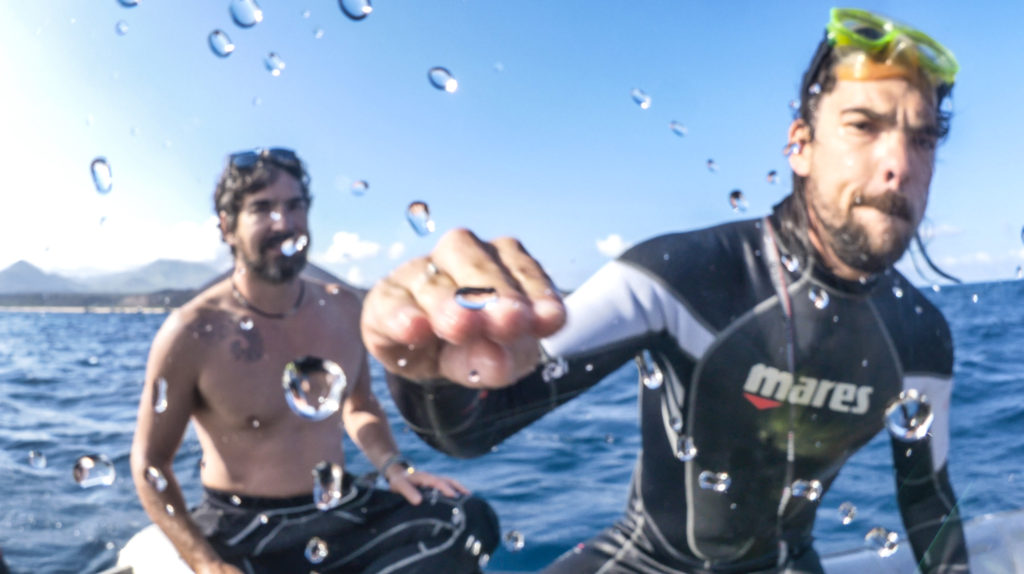 Mr. Brady recounting the behavior of the Shark after our ?rst dive.
Mr. Brady recounting the behavior of the Shark after our ?rst dive.
Still peering down into the water, a moment later Brady lifted his head, took off his BCD and pulled himself up. The look on his face re?ecting the feeling within my chest. We decided as a group to call off the next dive for Brian and Karin, as the shark's interest seemed to be peaked and we didn't feel like testing how far his curiosity would go. We made our way back to Delos, Brady explaining along the way that out of the hundreds of sharks he had dove with, never once had he felt like that in the water. After a tea and a hot shower, we sat down to empty the cameras and check back through the footage. Filming while diving is incredibly special because the camera adds a whole other element to the diving experience- it encourages you to seek out the ?ne details, focus on the behavior of a single ?sh for a while & most importantly, allows you re-live your experience over and over again. After reviewing the footage, Brady & I both agreed that it must have been our physical reactions to the Galapagos that elevated his aggressive behavior. After talking it over, we felt keen on attempting to meet one again in a more peaceful way.
 Alex ?lming the beautiful lava formations.
Alex ?lming the beautiful lava formations.
A few days later, we ended up on a boat to film the local annual ?shing competition. We left the pier at 5am and boarded the 'Argonaut', a beautiful 38 ft ?shing boat from St Helena. The captain's name was Craig, a burly South African fellow who had ?rst came to Ascension six years ago because of the epic spear?shing. His partner, Ellen, discovered Ascension last year via her interest in underwater photography. She booked a trip on the boat which Craig was working and they quickly established a bond over their passion for the ocean. Within two months, Ellen returned to the island, and together they purchased the Argonaut to start a new business with the ultimate goal of sustainability. I began chatting with Ellen and was immediately blown away by her knowledge of Ascension and her conservation work. A few hours later we returned to the pier empty-handed, along with about 90% of the other boats. Craig explained to us that last year's fishing competition had each boat returning with over 20 tuna each. Although I knew this was a fisherman's exaggeration, it was very clear that some big changes had been happening in the ocean here. Becoming more intrigued by the moment, I asked Craig and Ellen if we could arrange an interview for the next day & they happily agreed.
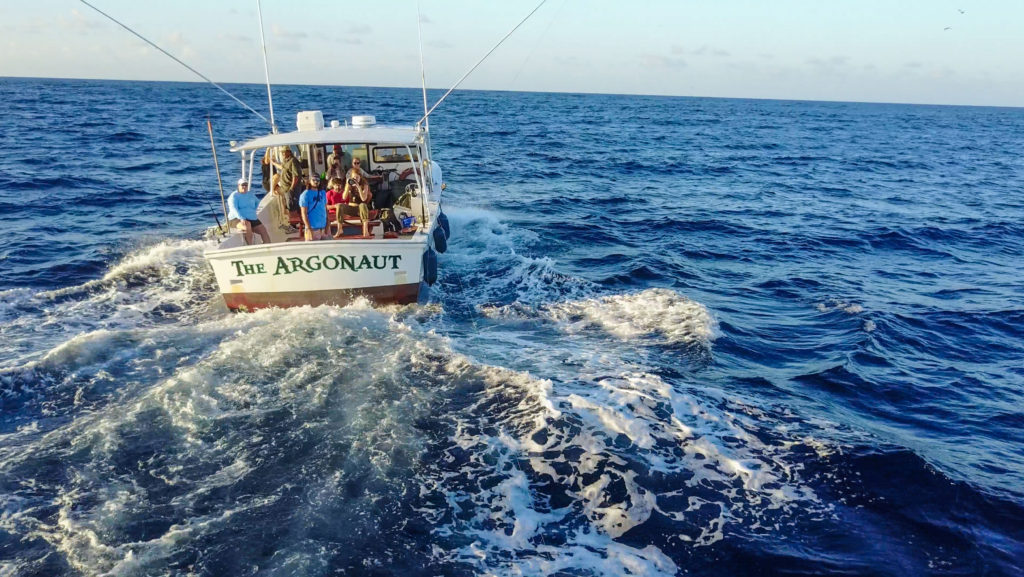 The Delos crew aboard the Argonaut from a drones-eye-view.
The Delos crew aboard the Argonaut from a drones-eye-view.
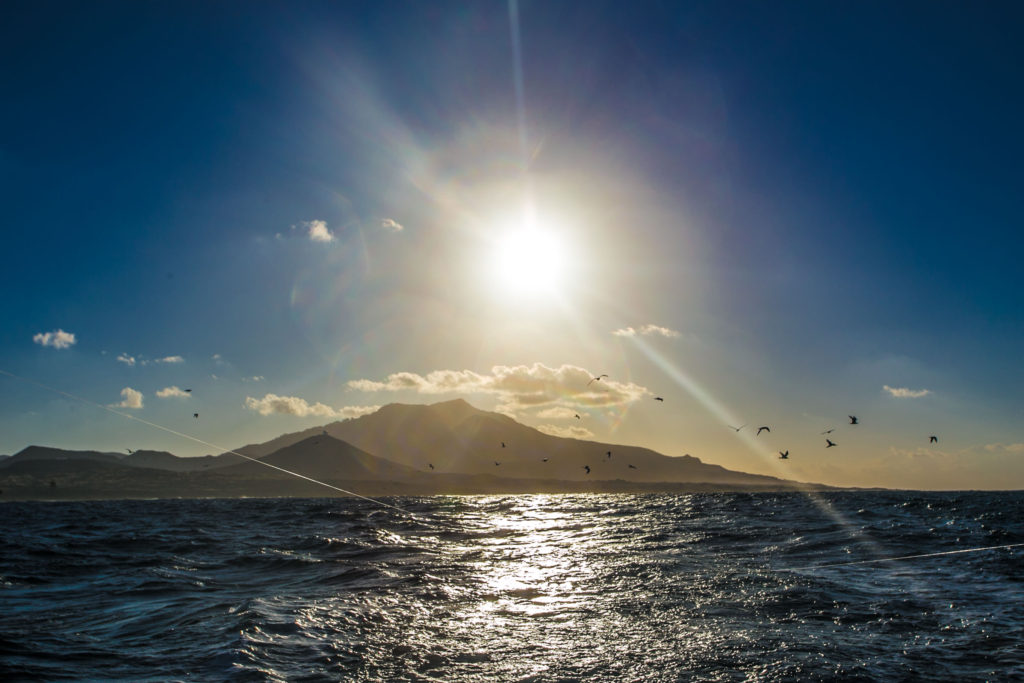 Ascension Island at sunrise, looking back from the Argonaut.
Ascension Island at sunrise, looking back from the Argonaut.
The next morning at the Obsidian Hotel (the only hotel on the island) Brady & I started our conversation with these two in an attempt to get the full story. Craig explained that when he arrived in 2011 the island was "virgin territory" with the only other sportfishing business starting 8 years before. He began working for a business that only had two little boats with outboard motors. Even so, he quickly found success thanks to the unimaginable amount of massive fish in the water. But soon after, Craig's perspective of the industry started to change.
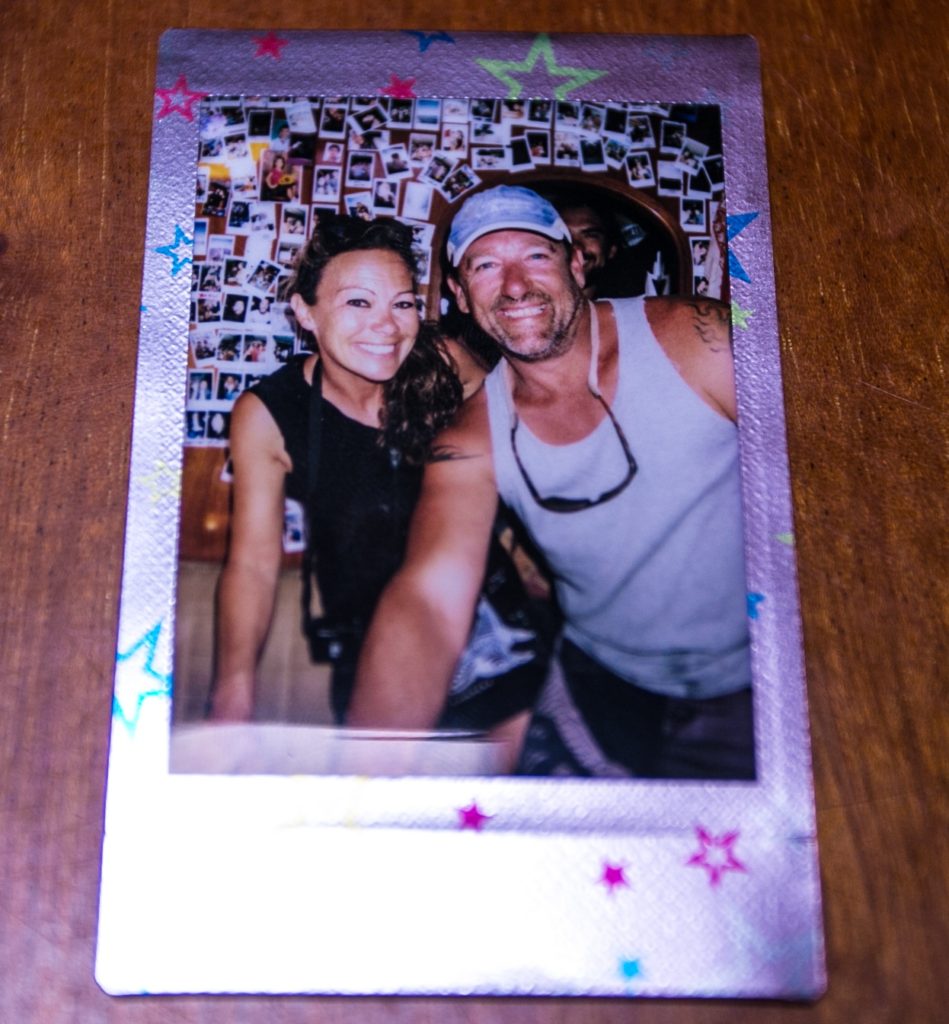 Traditional Delos Polaroid of our new friends, Ellen & Craig.
Traditional Delos Polaroid of our new friends, Ellen & Craig.
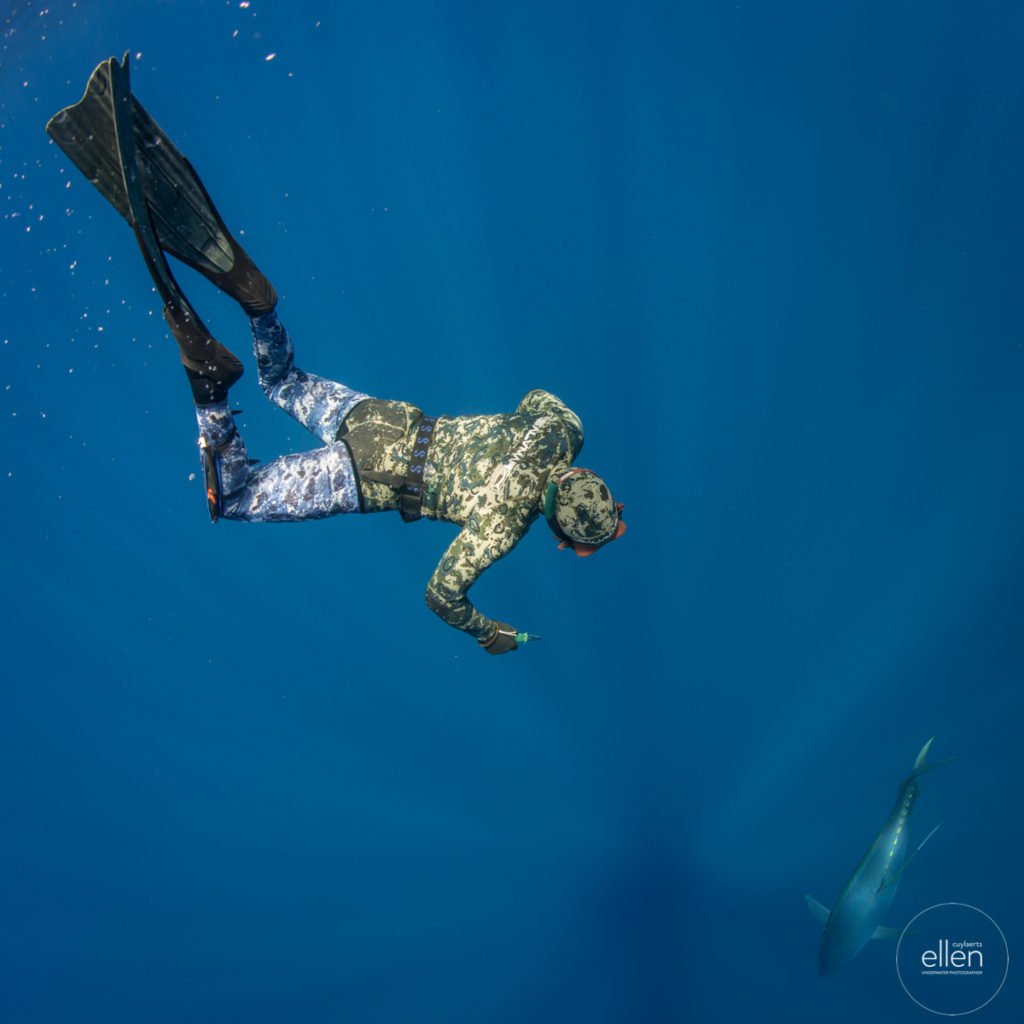 Ellen captures Craig free diving with a Yellow fin Tuna.
Ellen captures Craig free diving with a Yellow fin Tuna.
"When two or three 100 kilo fish are coming out of the water a day, that's everyone's food on the island for a week." Craig explained. With only 700 people on the island and almost no freezers at the time, there was a lot of fish going to waste. Finally, they managed to get more freezers set up, but there were still hundreds of kilos of meat getting freezer burned.
"I was getting a bit disillusioned by it because I wasn't brought up like that. So, I confronted my friend and said 'Hey man, we gotta change things here… We are wiping the Tuna out.' Cause there's never been a study done of the island so, nobody knows- how much Tuna is there? Are they residents? Do they migrate? So we don't know how sensitive or abundant it actually is yet."
He explained that older studies claimed that it took 7-9 years for a Tuna to reach 100 kilos, but more recent studies have shown that it takes more than double that time for the fish to reach this size and become mature enough to breed.
"Those are the fish that know where to breed, they have been evading the long lines and the fishermen. Those are important fish to have in the eco system, you can't wipe out all the big ones."
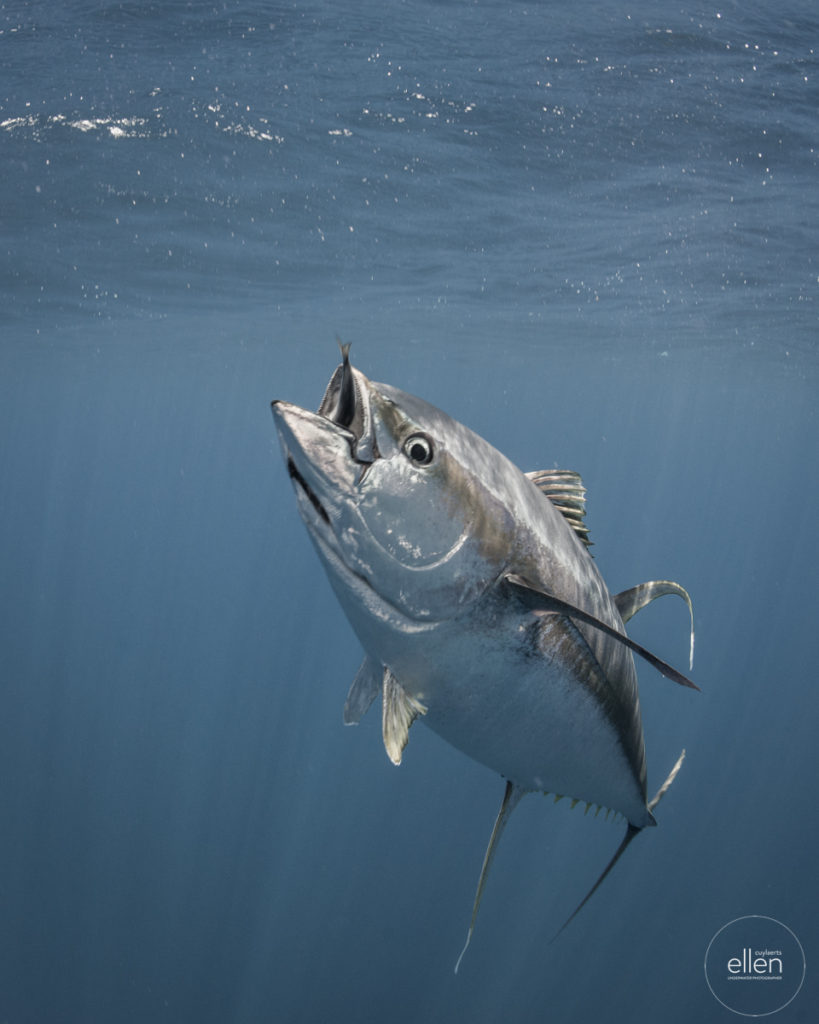 One of Ellen's shots of the Yellowfin Tuna having a snack.
One of Ellen's shots of the Yellowfin Tuna having a snack.
Craig continued on with gruesome detail about the nature of the spearfishing for sport business and the clients that he dealt with on a regular basis. Wealthy people from the UK or America would come in for the weekend with photographers & the sole goal of shooting the big ones, cutting off a sickle or bill as a trophy, getting cool photos, and then dumping the fish back into the water.
"That's what it became," he said. " 'Oh, theres another big one so I will shoot it as well.' And I'm like, 'No man, you tossed your last one back in after cutting the trophy because you were too lazy to let it.' and he's like, 'No I paid, I want to shoot it.' And then sometimes to not even get a picture with the fish! 'How heavy is it? Oh, 113 kilo… Yesterday mine was 118 kilo. No picture, no picture- drop it.' "
It's at this point that Ellen chimes in, "It's killing an animal you don't really need to kill, just for the fun of killing. When it comes to the locals you have the Saints, they respect the Ocean mostly. But then you have temporary visitors or RAF & US Air Force, they are just here for a few weeks or years to have a good time. They don't understand what's actually going on in the water."
Upon meeting, Ellen and Craig decided to team up and start a more sustainable business named Ascension Island Adventures. Their main goal is to focus on catch & release, underwater photography, scuba diving, snorkeling, and spending quality time in the water with dolphins, turtles & sharks.
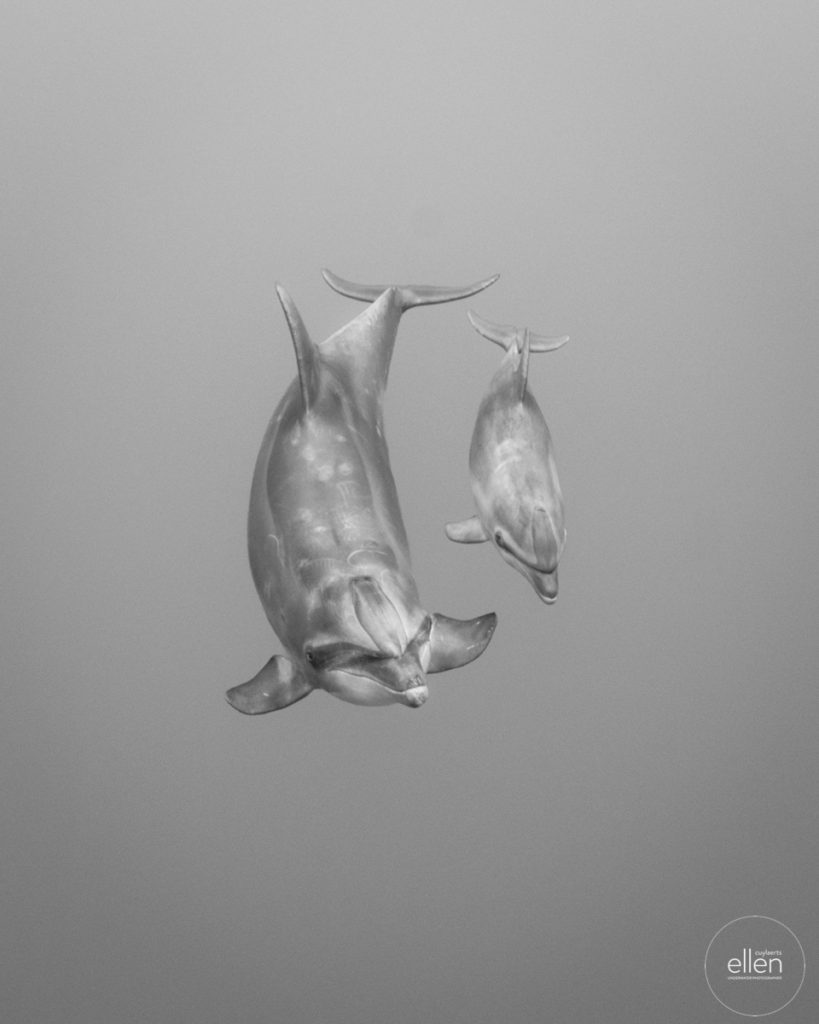 Bottle nose Dolphin in Ascension, showing off her calf for Ellen's camera.
Bottle nose Dolphin in Ascension, showing off her calf for Ellen's camera.
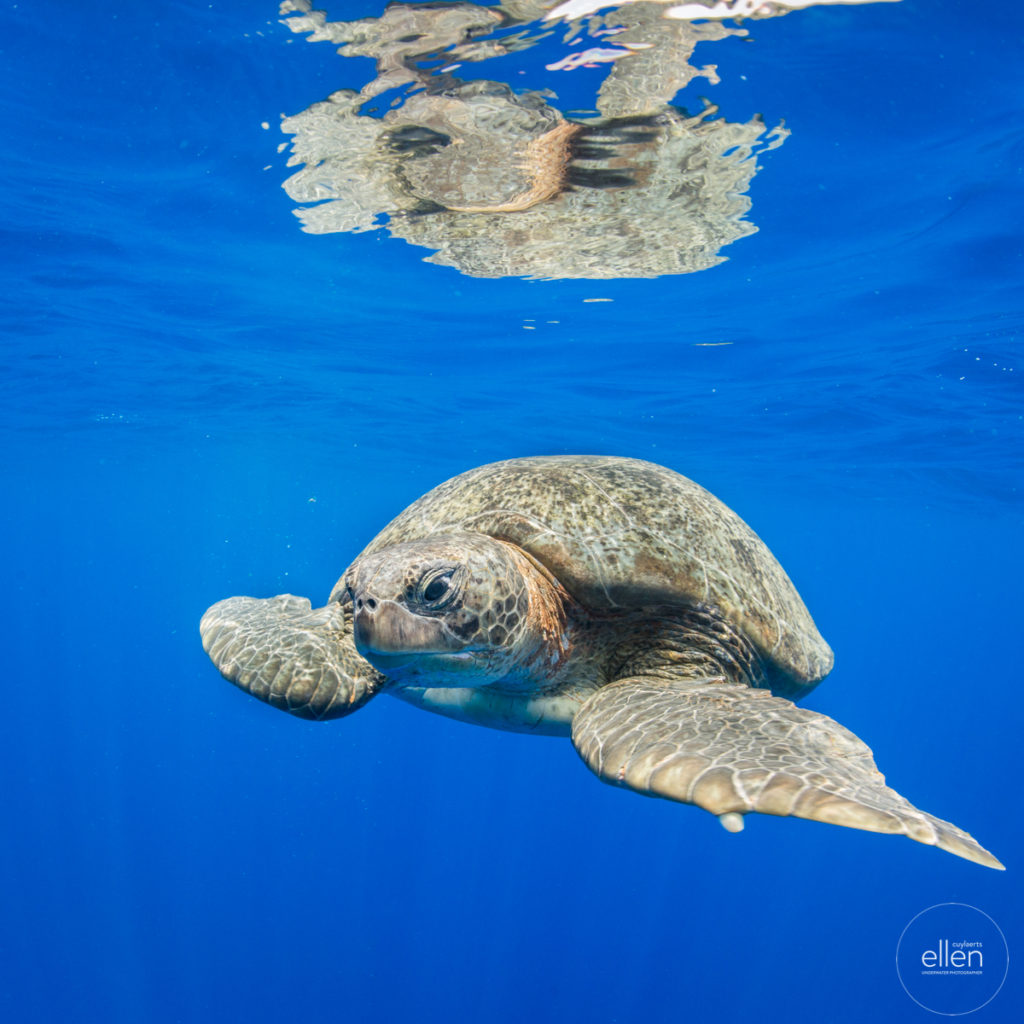 Ellen captures a peaceful Green Turtle near the surface. Between 20 and 30 thousand nests are laid annually on Ascension .
Ellen captures a peaceful Green Turtle near the surface. Between 20 and 30 thousand nests are laid annually on Ascension .
I asked them to explain the changes they have been seeing over the last couple of years. Craig spoke first, "Definitely in the Black Jack area- you need these for chum to get the Tuna. We've never had sharks so you could float at the surface with a big stinky bag of chum and just hand feed I've or six Tuna before having to swim back to make the kill. They are just brushing the edge of your spear, there's no skill involved, it's not even fun…"
"No, no- hand feeding tuna is fun," Ellen interrupts. "If you are shooting them with cameras and not spear guns!"
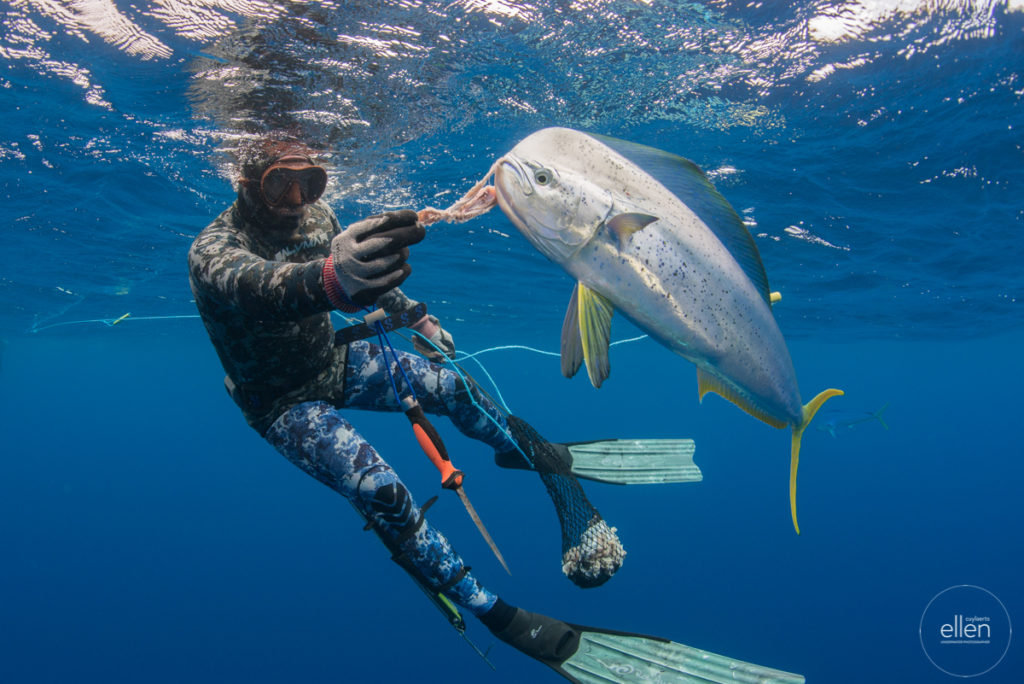 Craig hand feeding a Mahi out of a chum bag.
Craig hand feeding a Mahi out of a chum bag.
They explain that in fact there were always Galapagos sharks here, but they were in small patches on the other uninhabited side of the island.
"Ay, everyone's got their own theories on why," Craig says. "Lil' pieces of the puzzle you can put together- ocean currents being very cold, currents shifting, el nino year… maybe we didn't get our bait fish cause their highway changed." Craig continued on to explain that you can still hook fish here, but you can't land them because within ten seconds there's a massive red explosion on the surface. Fisherman are used to pulling fish out with a chunk missing or tail bit off, and refer to the common occurrence as 'the tax man taking his cut', but the difference now is that the sharks are frenzying and eating an entire fish in seconds.
We then asked Ellen to explain her experience with the Galapagos Sharks in comparison to her other shark experiences. From my conversation with her the other day, I already knew she had dove with Tiger Sharks in the Bahamas and Orcas in the Arctic.
 Ellen getting up close and personal with Tiger Sharks in the Bahamas.
Ellen getting up close and personal with Tiger Sharks in the Bahamas.
 Ellen diving with Orca Whales in the Arctic.
Ellen diving with Orca Whales in the Arctic.
"I've been diving with the boldest sharks," she explained. "For me it was Oceanic White Tips- they bump you and they are inquisitive and very smart. I thought if I could learn to control those, be in the water, keep my heart rate down, keep an eye on them with 12 or 13 of them around me- that's good & I can do this. Then last year, we were in the water here taking images of Tuna & Mahi with a small chum bag and then suddenly 5 or 6 Galapagos came from the side and underneath and were really trying to separate me, close in on me, and keep me away from the boat. And that's the moment when I thought- eek! I'm gonna get out of the water. And I'm not ashamed to say it because it's still the ocean- it's their territory, so when I don't feel comfortable, I get out. But the behavior of these sharks is definitely more inquisitive and more aggressive than anywhere else in the world I have seen. Normally you can see patterns and predict their behavior- After a while they see you're not food, not a weak or sick fish, and they leave you alone. They are the ocean cleaners, we need them- they keep the fish stock healthy, which keeps the reef healthy, so we need them. But these Galapagos sharks are waiting until you make a mistake, that's how it feels when you're in the water. I'm not saying they are monster sharks, they're just being sharks."
Sharks have long since been made the monsters of the sea through the media, but in fact are incredible creatures. They are among Earth's most ancient animals, with the fossils of their ancestors dating as far back as 400+ million years- which is about twice as old as dinosaurs! They have managed to survive all five major mass extinctions on this planet, but are now facing a major threat from humans. Although used worldwide, shark fins are in high demand in China for the delicacy of shark fin soup and traditional cures. The shark finning industry involves hooking sharks on long lines, pulling them aboard, cutting off the fin while the shark is still conscious, and discarding it back into the sea where they are unable to swim and therefore suffocate or are eaten. This multi-million dollar industry values fins from $300-700 a pound, and this practice causes the death of an estimated 100 million sharks every year. It is believed that in the last 15 years, 60-90% of the shark population has been lost and some scientist believe the shark species will disappear completely within the next ten years. With numbers like these, it becomes clear why understanding and protecting sharks is of great concern and importance.
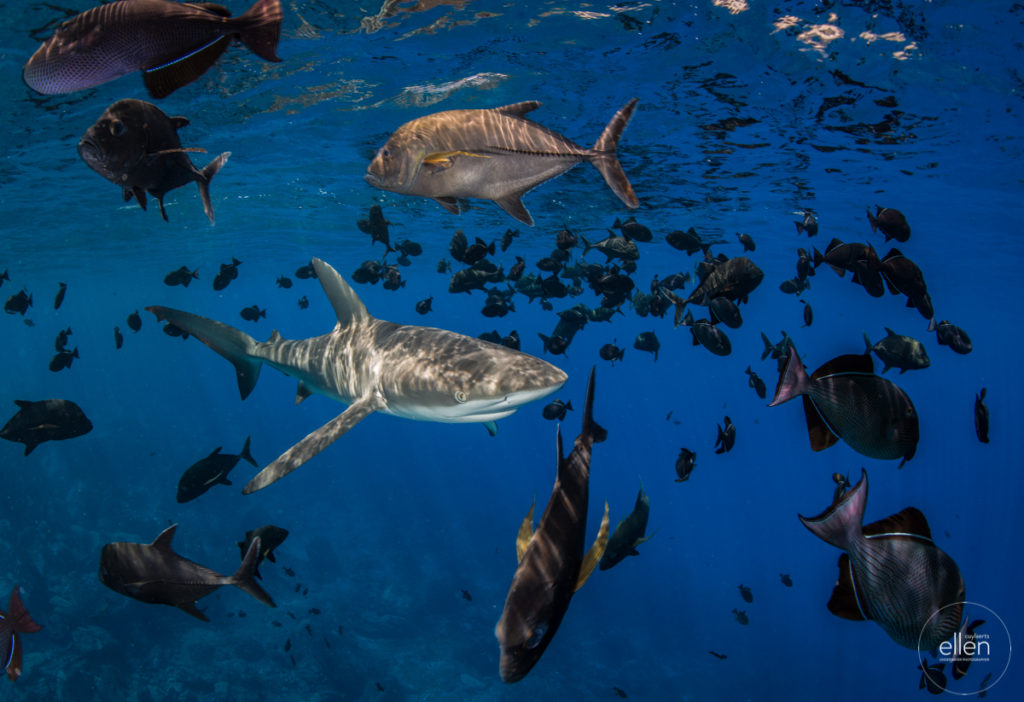 Ellen finds a Galapagos surrounded by Trigger fish & Trevally at Botswain Bird Island.
Ellen finds a Galapagos surrounded by Trigger fish & Trevally at Botswain Bird Island.
 Galapagos getting up close and personal with Ellen.
Galapagos getting up close and personal with Ellen.
During the interview, Craig & Ellen sat in front of a wall covered with dozens of trophy fish photos caught around the island. At one point she commented that she would love to see more photos of fish underwater instead of trophy fish, "I think times are changing… Some people still do like it, the trophy fisherman… And I do believe in catching fish if you need food. But I don't think that images like this are provoking a positive feeling anymore in these times when the oceans are suffering so bad, I think minds are changing."
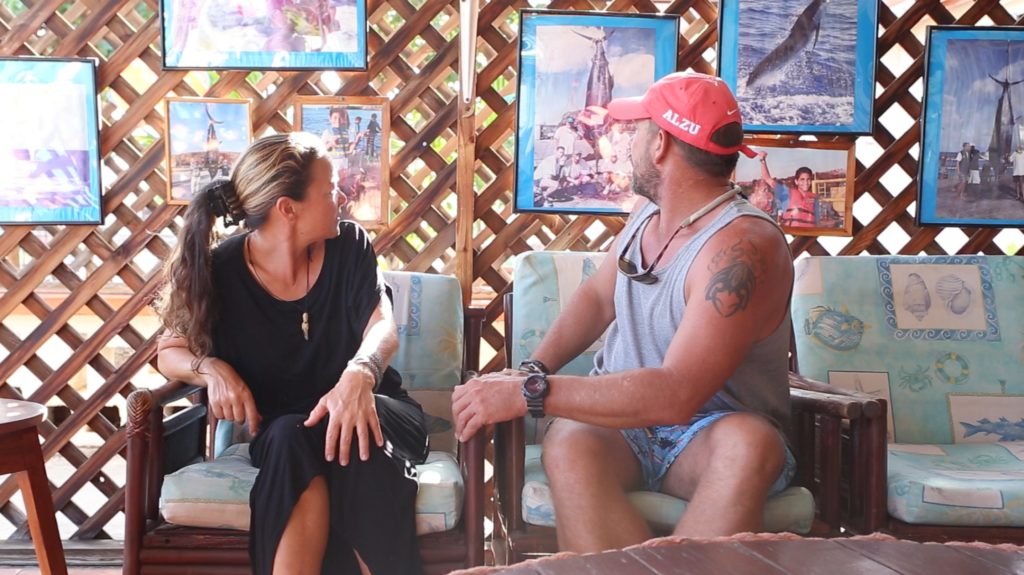 Ellen & Craig chatting about the trophy fishing photos.
Ellen & Craig chatting about the trophy fishing photos.
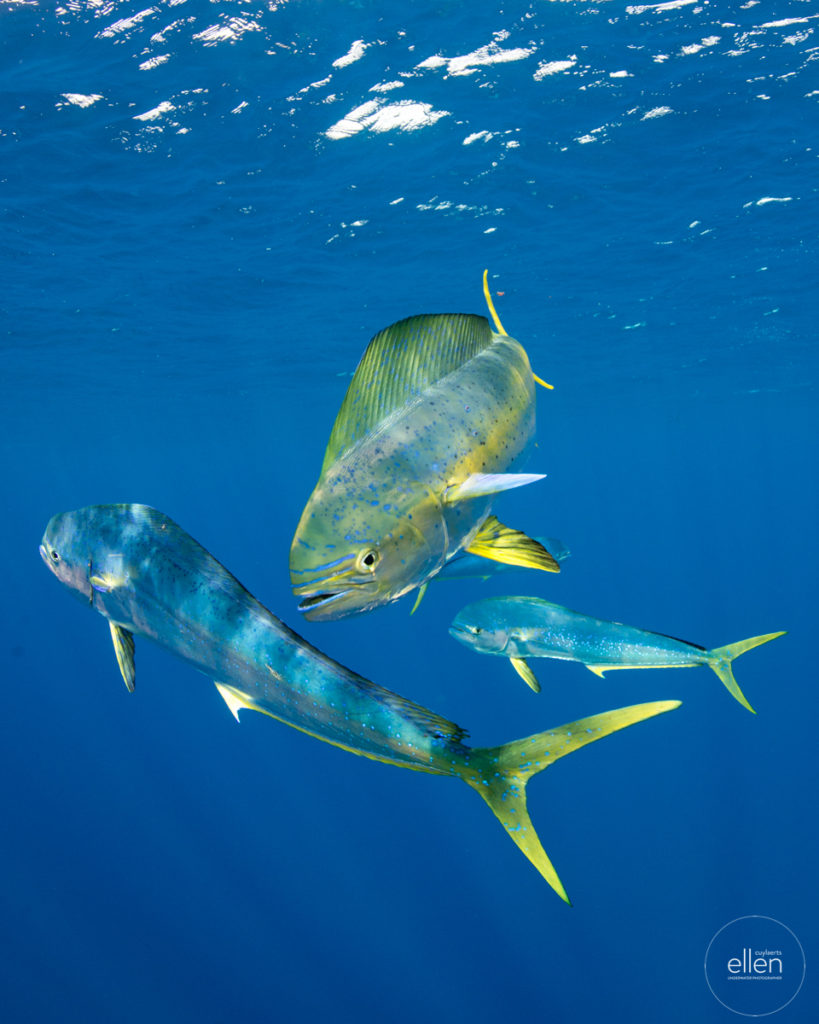 Ellen captures a Mahi trifecta showing off their true colors.
Ellen captures a Mahi trifecta showing off their true colors.
"We are getting a lot more fisherman who refuse to catch and keep a fish!" Craig chimes in. "Now, sometimes I have to say 'Come on man, we need fish on the island for the people.' But a lot won't even keep any fish because they realize if they continue on in this way, they won't be able to fish at all in the future. I mean, maybe in ten years it's all dead and we say 'Oh shit… You know what we did? We wrecked the place.' And then it's too late. And who's to blame? Only us." They both go on to explain tactics for future sustainability including setting minimum and maximum sizes, limits per person, and protecting specific fish during their peak breeding season.
At this point, the Island Government won't renew their business license because there is no guarantee when the airport will re-open. There used to be two UK Falkland Airbridge flights coming in and out a week with 10 civilian seats, but in April authorities deemed the cracks in the runway too dangerous for this plane. This means that now the only way to travel to Ascension is to either sail there yourself or purchase a 2,000GBP ticket on the RMS mail & supply ship which takes 10 days each way and leaves only from Cape Town, South Africa. Most businesses on the island are pulling their boats out of the water or shutting their doors for extended periods.
I asked if they were considering selling their boat.
"We aren't here actually to offer fishing trips…" Ellen replies. "We are here to change the way they fish, and to offer something different than there was. We were making a small difference, we offered an alternative and were changing lives, so if we leave now we are losing- if we stay, everyone is winning on conservation issues. We have to keep the pressure up a bit." Their hope is that once the airport is repaired, they can return and help be a voice in setting the standard for the businesses that re-open or new ones that are created. For now, Craig and Ellen would be leaving Ascension until the island was back up and running. When it is back up, they will be able to implement new and important business steps to appeal to those who want to do this type of fishing, for example, as technology advances, businesses like this will need to gain further safety steps such as meeting PCI compliance requirements to ensure that their customers are safe when using their services, this can also open them up to a wider customer base. Here's hoping they are able to achieve this.
After having the chance to view Ascension waters through the eyes of two divers who spend almost every day in it, we felt confident in our choice to continue on with our dives.
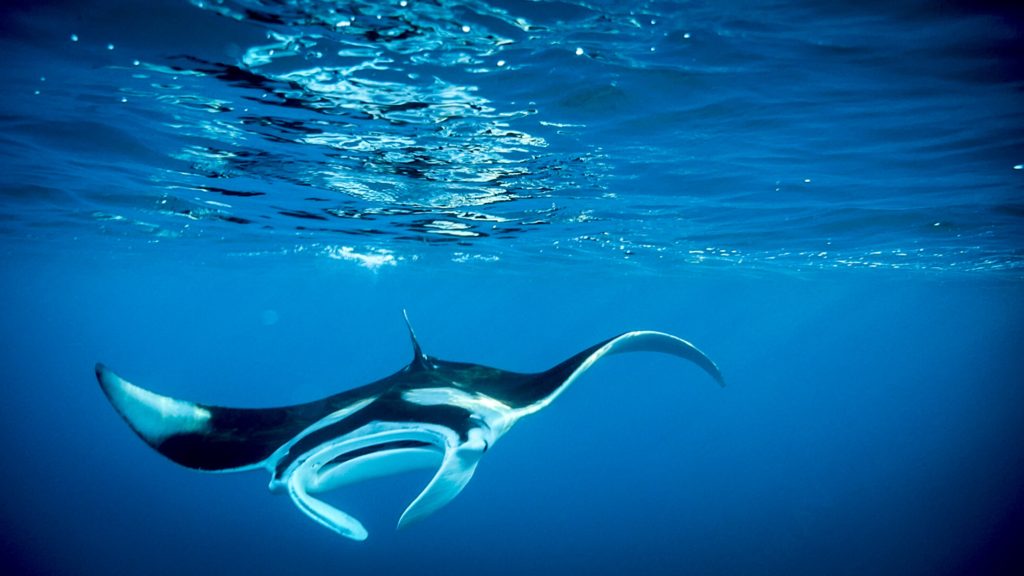 A massive Manta Ray we saw splashing from the dingy & managed to snap some shots of.
A massive Manta Ray we saw splashing from the dingy & managed to snap some shots of.
 The crew getting comfortable in Comfortless Cove after an epic dive.
The crew getting comfortable in Comfortless Cove after an epic dive.
In our remaining two weeks on Ascension Island, we got a taste of some incredible underwater beauty. We did a couple of dives out of Comfortless Cove, which earned its name from its use as a quarantine spot for yellow-fevered sailors back in the day. Just outside of the bay are the remains of an 1840's shipwreck, a plethora of fish & some very aggressive moray eels that attacked our cameras & flippers more than once. These bold eels became a constant part of our dives, along with Trigger fish, Trevally, Squirrel ?sh, Trumpet fish, Flounders, Rock fish, Puffer fish, Groupers, Urchins, & more. 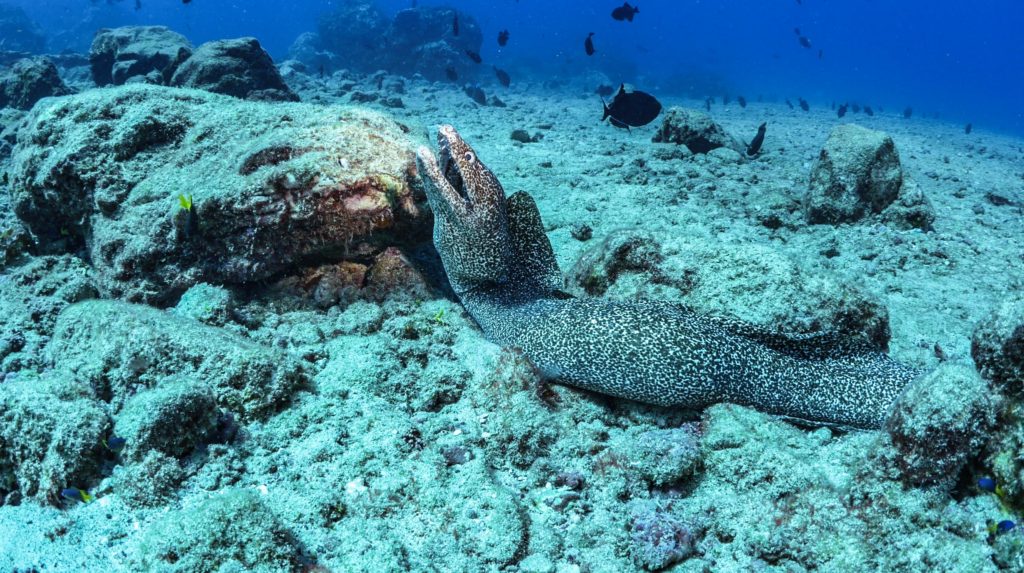 A brave Moray eel out in the open just before attacking our camera for the first of three times.
A brave Moray eel out in the open just before attacking our camera for the first of three times.
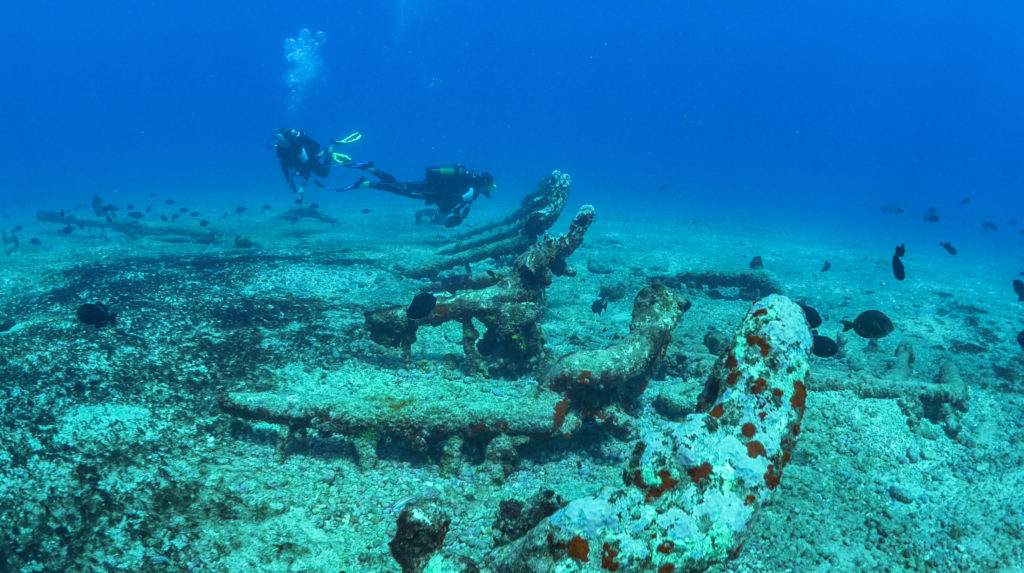 Alex & Brady investigating the 1840's Shipwreck remains.
Alex & Brady investigating the 1840's Shipwreck remains.
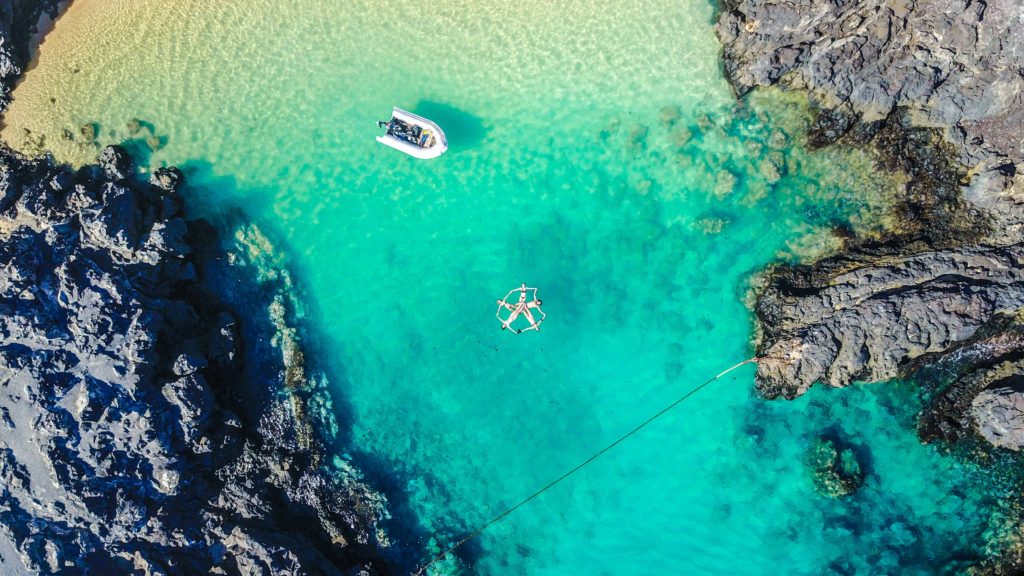 Drones-eye-view of the crew's human starfish configuration at Comfortless Cove.
Drones-eye-view of the crew's human starfish configuration at Comfortless Cove.
We dove "The Chariots" a dive spot near the Arch, where we had our first Galapagos encounter. This site is aptly named due to the sunken chariots that were pushed over board (for reasons unknown) and now sit almost 20 meters down on the ocean floor. We also dove the arch again as a group of four, and for most of our dives got lucky with 20-30 meters of visibility in 27C degrees of water. Each time we entered the water, we all prepared ourselves to encounter another Galapagos- but whether it was because we were in a larger group or just a fluke, we never saw another one on these dives. On our last week on the island, there were massive swells which unfortunately prevented us from diving the "Red Rocks" site, which consists of natural lava tube caves right off the shore. But every dive we did adventure on, we were sure to heed Craig's advice of holding a bristled broom to fend off over curious sharks. Apparently the bristles of the broom are an annoyance when they come in contact with the shark's sensitive skin, and although we never had to test the theory, it always made us feel better to hold something in our hands.
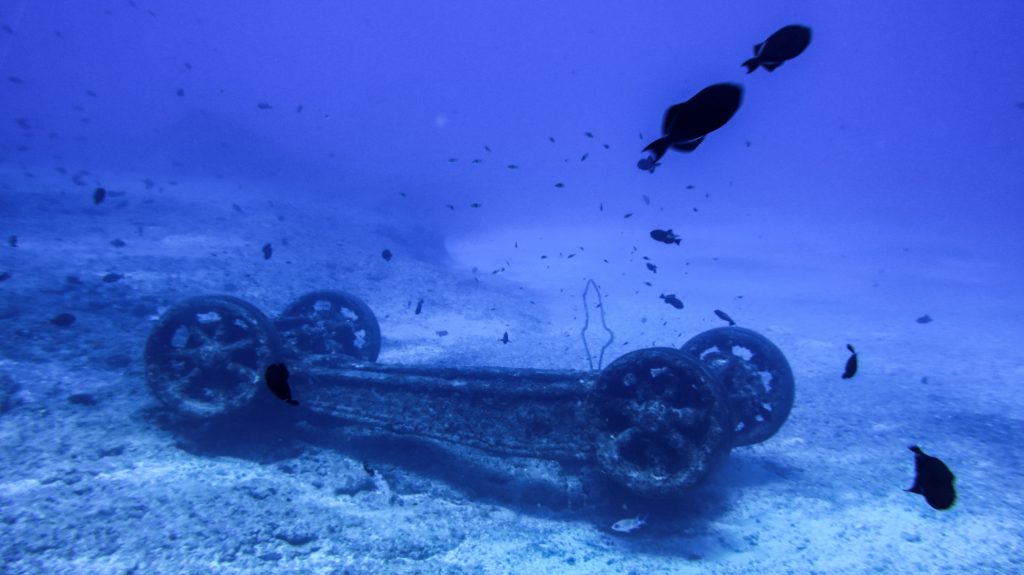 One of the several mysterious chariots in Clarence Bay.
One of the several mysterious chariots in Clarence Bay.
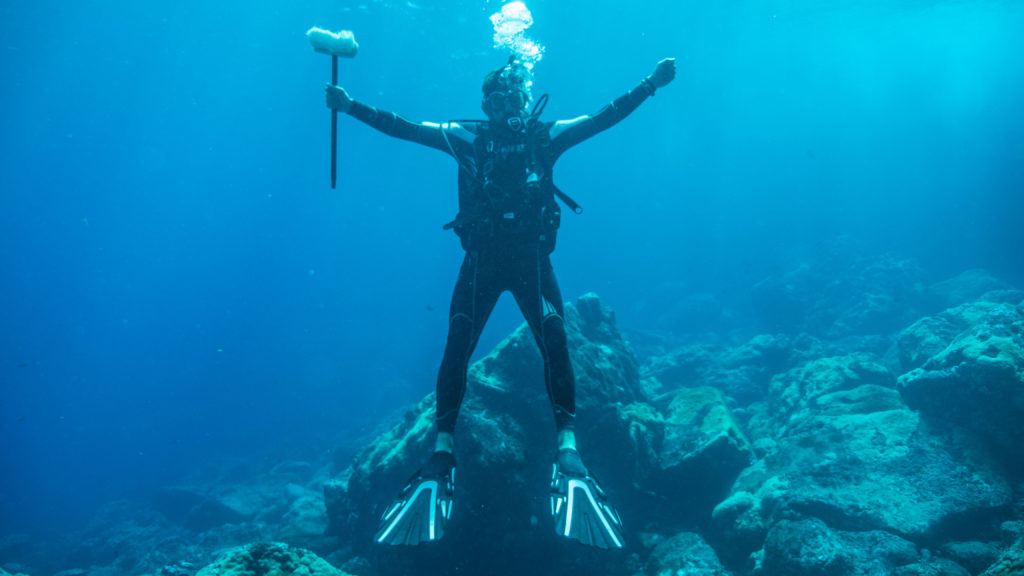 Captain Brian with his trusty broom!
Captain Brian with his trusty broom!
But there was one dive site that blew everything else out of the water. Botswain Bird Island sits about a mile off the exposed Eastern side of the main island and is an unspoiled little gem both outside of the water & in. It was about a two hour motor from our anchorage, and about half way there, Delos acquired many escorts in the sky. The island acts as sanctuary for Masked Boobies, Frigate birds, Petrels, Tropic Birds & Fairy Terns. I grabbed my camera and just laid out on the deck, taking hundreds of photos of these beautiful creatures- flying together, ?ying alone, eclipsing the sun and just being happy in their natural environment.
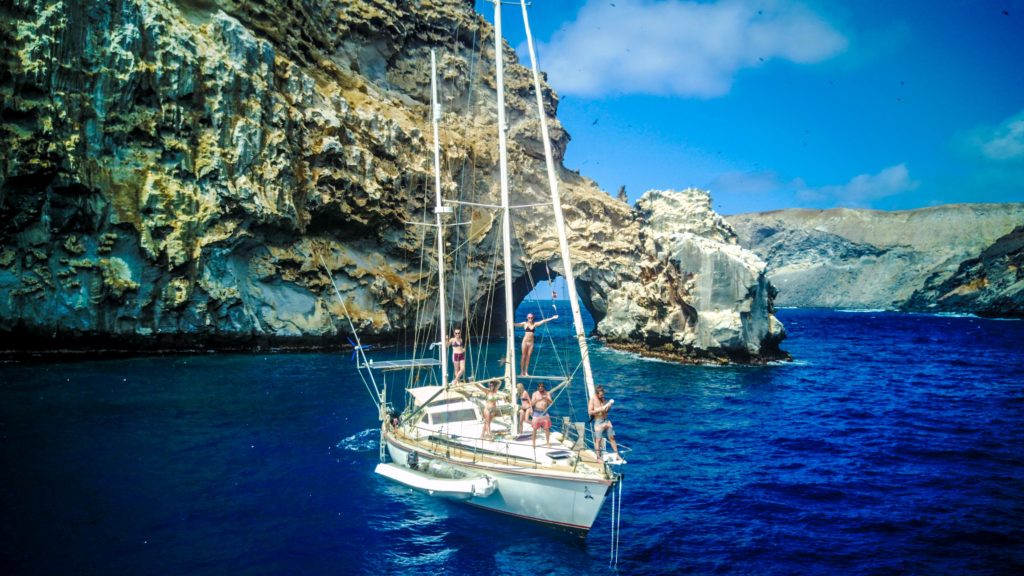 The crew thoroughly enjoying themselves while anchored next to Botswain Island.
The crew thoroughly enjoying themselves while anchored next to Botswain Island.
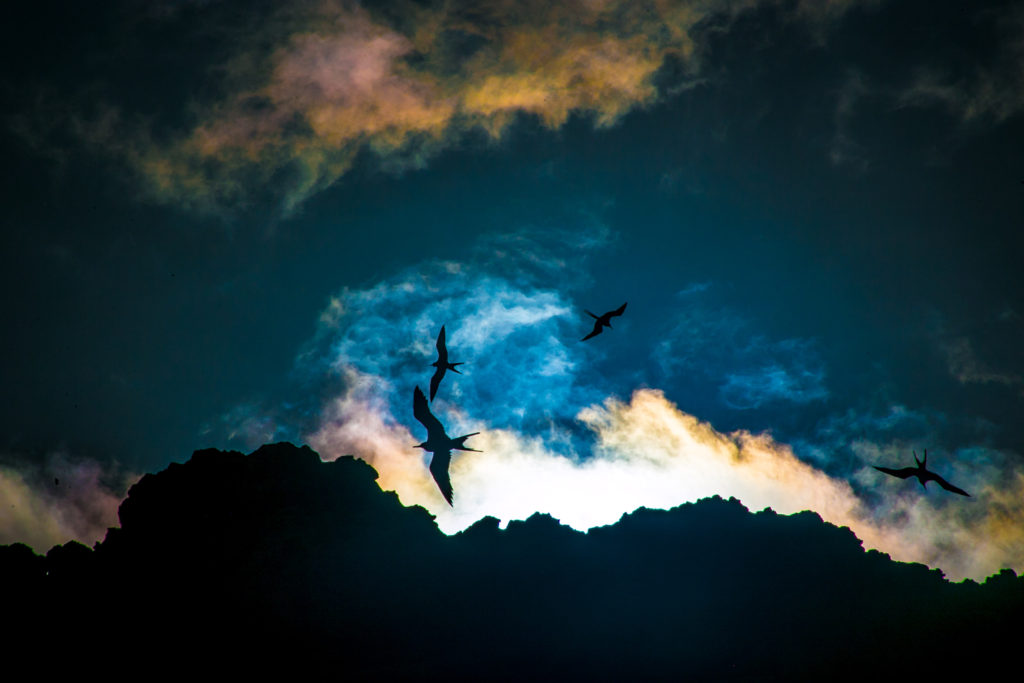 Frigate birds flying high above Delos as the sun is rising.
Frigate birds flying high above Delos as the sun is rising.
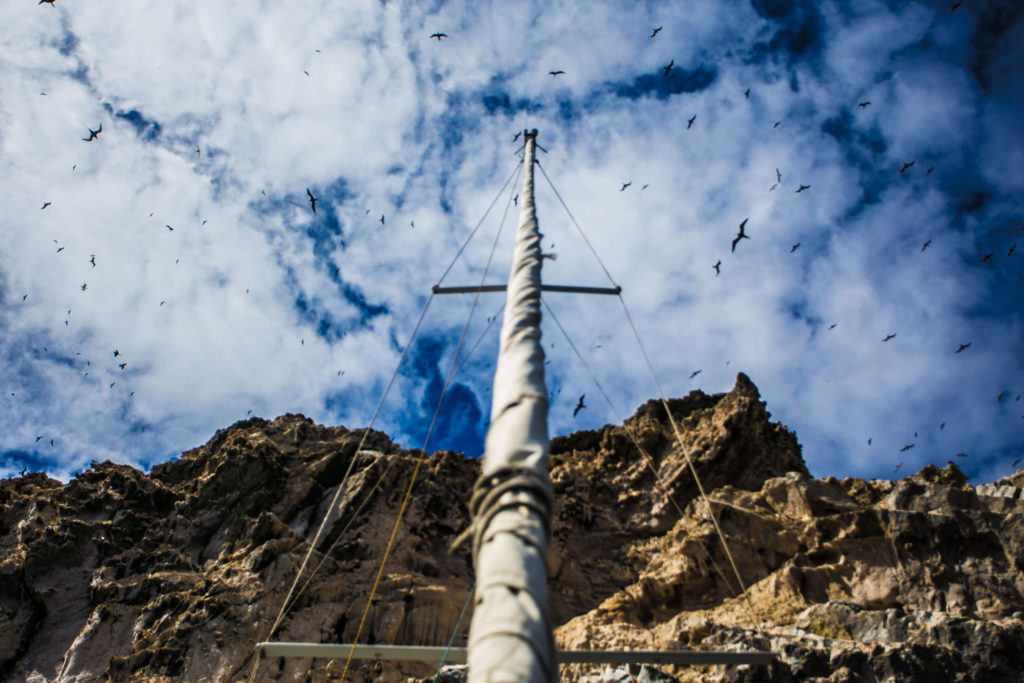 Imagine how dirty Delos was after spending a couple days anchored here…
Imagine how dirty Delos was after spending a couple days anchored here…
Some highlights for us at Botswain were the extremely large & friendly Trevally that would cruise with us for an entire dive, meeting an adorably determined three legged turtle, diving under the archway (which felt like a washer machine when the swell picked up), and experiencing a safer and cuter side of Galapagos sharks from all the juveniles that lived here. There were several moments when I was so overwhelmed underwater that I could no longer swim along or focus on just one fish. I had to just stop and spin around to fully absorb the scene in its entirety- dozens of different fish species in big healthy schools living peacefully together in this healthy ecosystem.
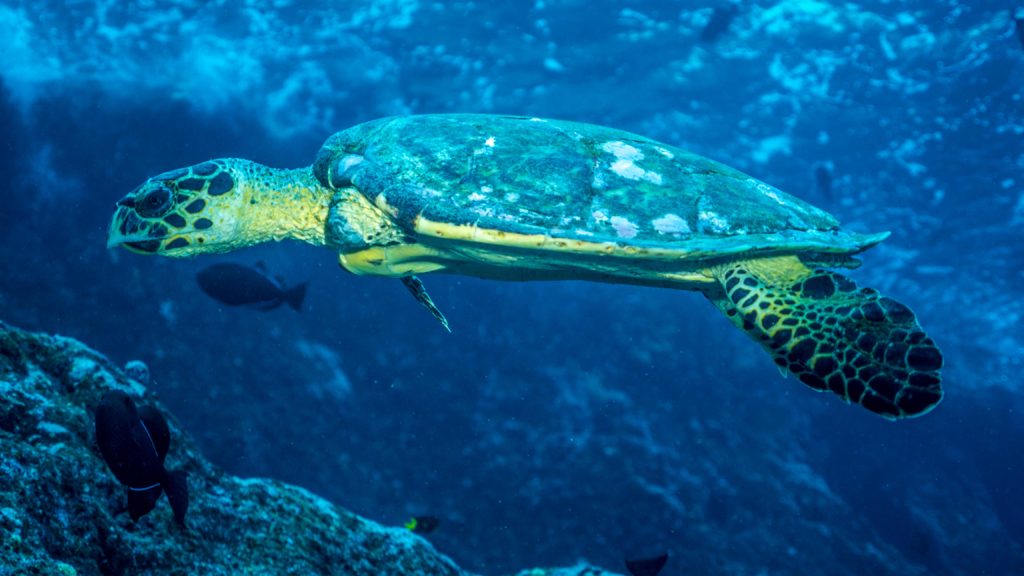 The resident three-legged Hawksbill Turtle that we met under the Arch.
The resident three-legged Hawksbill Turtle that we met under the Arch.
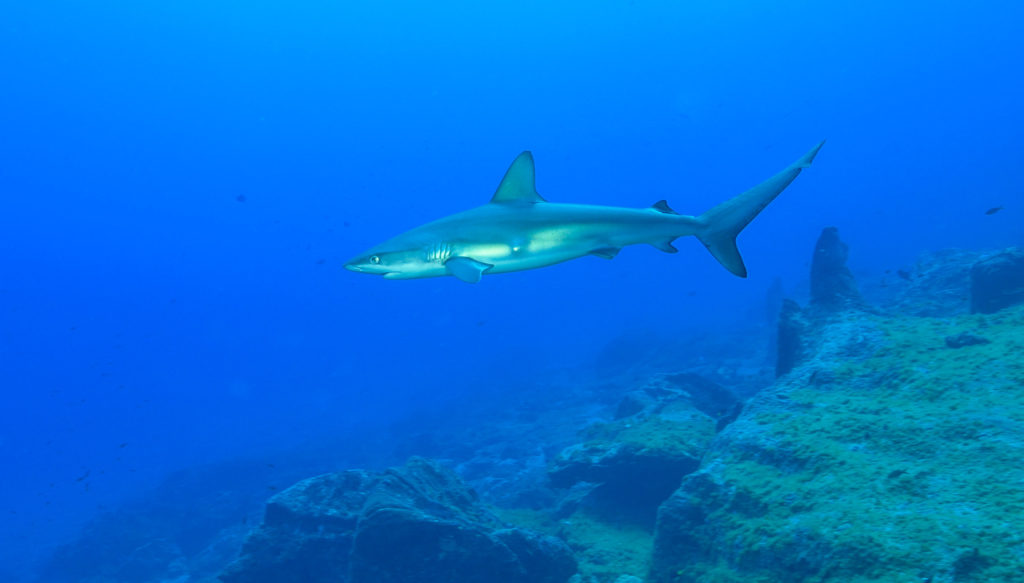 Baby Galapagos Shark being curious about us divers.
Baby Galapagos Shark being curious about us divers.
I also had the most terrifying underwater experience of my life here. It was on our third dive of the day around the North side of the island. About half way through the dive, I found Brian motioning for me to come over and check something out. There was a very narrow, slotted cave- and since I was holding the GH4 camera with the lights, I was the one who should, of course, enter first. I looked at the cave with doubt. What the hell was in there? A voice told me to hand the camera over to Brian, but I pushed aside the feeling of unease.
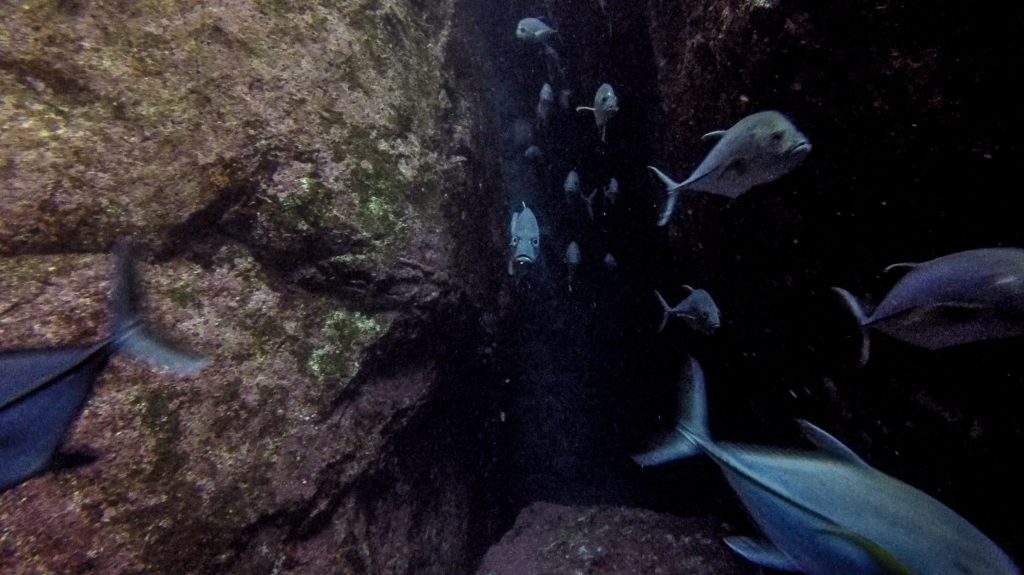 A school of Trevally exciting the slotted cave as we entered.
A school of Trevally exciting the slotted cave as we entered.
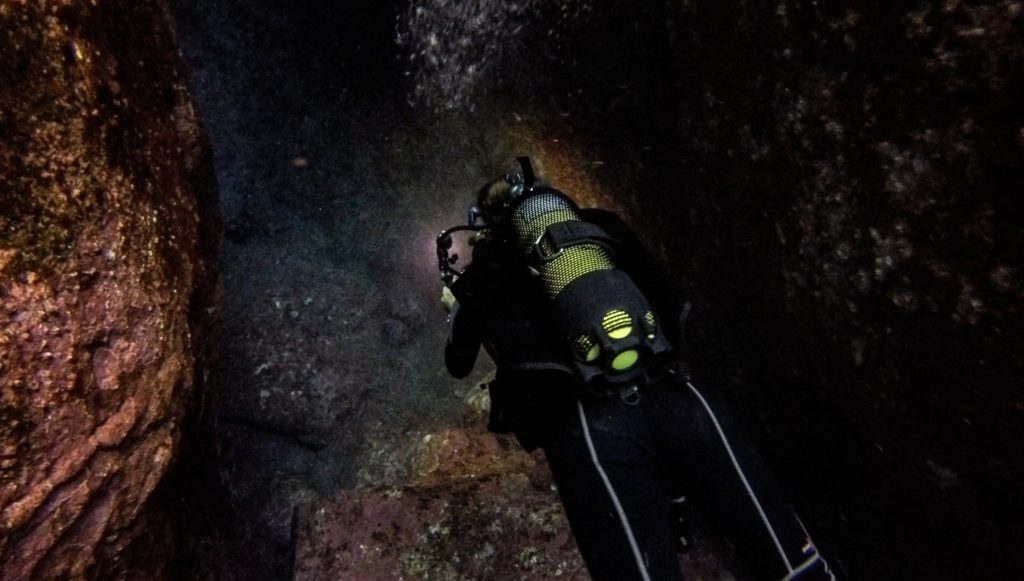 Alex making the first turn into the mysterious cave.
Alex making the first turn into the mysterious cave.
We hung around the mouth of the cave for a bit and felt absolutely no surge, so I slowly cruised in to find the cave zigzagging to the left. With Brian right behind me, I entered deeper, the cave snaking again to the right. Just as we came around the next twist my mind told me no, and I turned back around. And then the surge came… Within an instant we were sucked 3-4 meters deeper into the darkness, kicking furiously in a pathetic attempt to fight it. The surge blasted back the other way and slammed us into the crusty cave wall. Brian managed to grab me and brace his feet against the wall to help push us back the way we came. Another sucking surge came through and I kicked for my life in absolutely unswimmable conditions. The next surge launched us out to the other side of the cave, now nearer to the exit and with the camera in one hand I managed to grab onto a slight indent of the cave wall. I held on with all my might as the following surge attempted to rip us back into the unknown darkness.
It didn't feel real, it didn't feel like only water rushing past us- the cave felt hungry. Like we had just swam into the mouth of a sea creature that was so big we didn't even see it for what it was. And then whoosh, we were spat out of the cave back into the open blue to find Karin also fighting the surge even a good 10 meters out. My racing heart cried for air, and I remembered I could actually breathe. I looked down at my throbbing hand and saw discolored green blood from the cuts on both sides- That was a first.
To me, the craziest thing about the ocean is that every time it terrifies me by pushing my limits, once I catch my breath, it only makes me more keen to jump back in. I guess the ocean can be a crazy thing in that way… Although she allows you to witness her world, it takes only a fraction of a moment for her to remind you exactly how powerless you are in her hands. But the more she shares with you, the deeper you fall and the riskier the whole love affair becomes.
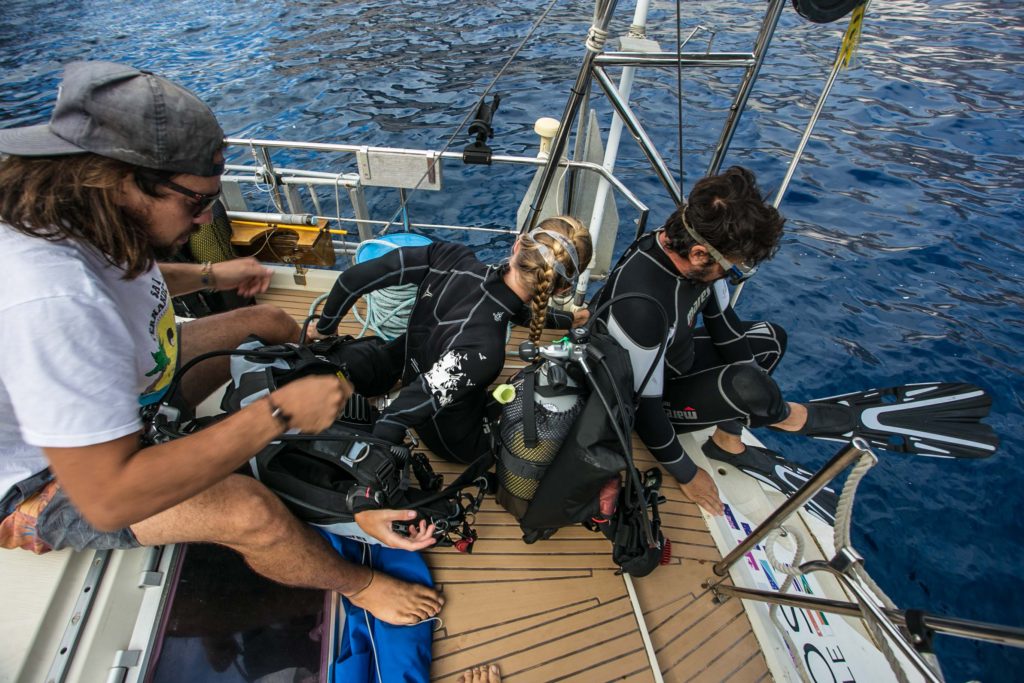 Brady helping Karin & Brian get geared up to dive off the back of Delos.
Brady helping Karin & Brian get geared up to dive off the back of Delos.
After three weeks in Ascension, I felt we had only begun to scratch the surface of what this magnet in the middle of the sea had to offer. It's hard to describe the feeling of being somewhere so incredibly remote. So removed from a world that can sometimes feel like it's falling apart or damaged past the point of repair. To slip away from society and internet and people and dive into a different world that is still so pure, alive and working harmoniously in perfect unison. To find art in the most natural of places and to have the chance to use our cameras to capture this and share with others. These things I saw and felt are things that I will never forget, and things I know that one day will lead me back to this paradise that stands alone in the Atlantic.
Much as Ascension was the question mark for our ocean passage, its future is drenched in the unknown. After a 15 day, 2,400 nautical mile sail to Ilhabela, Brazil- we reconnected to the internet to discover there had been another shark attack on the Island one week after we left. My heart sank upon reading this news, as I fear what the people of Ascension will do to "eliminate" the issue now that the sharks' strongest advocates had left. Nobody knows the future of the Galapagos sharks in this area, or for that matter, the Tuna and all of the other sea creatures that are blessed to call this island home. Nobody knows if or when the airport will be repaired, and how long the island has to repair the damage done by humans. Nobody knows what businesses will want a stake in this paradise, and how they will choose to respect or ruin everything it has to offer. All we can do is wait patiently, and see how Mother Nature wants to see the fate of Ascension Island to play out.
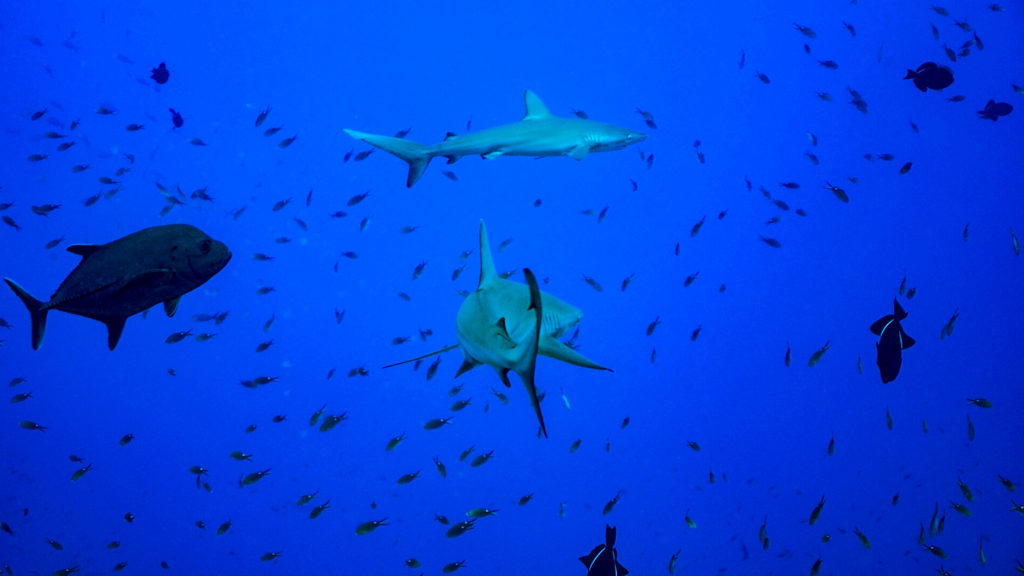 Baby Galapagos' in a school of fish.
Baby Galapagos' in a school of fish.
If you are interested in standing up against shark finning, click here for some ideas on how you can help!
If you would like to learn more about the adventures of SV Delos, click here!
glassoprobbild1991.blogspot.com
Source: https://svdelos.com/blogs/ascension-island-underwater-wonderland-uncertain-future-alex/